Middle School Overview (Schedule, Recipes, etc..)
OLD TESTAMENT
MIDDLE SCHOOL
This file is provided as a resource for Church School directors. Feel free to plug in your own dates and your own teachers.
Teachers:
Schedule of Classes:
|
Date |
Teacher |
Lesson/Activity |
Special Notes |
|
September 13 20 27 |
|
Creation Adam & Eve/The Fall Noah |
|
|
October 3 4 11 17 18 25 |
|
Movie Night: Noah Tower of Babel Abraham Movie Night: Abraham Isaac Jacob |
Outdoors if possible
Social Hall after Vespers
|
|
November 1 8 15 21 22 29 |
|
Joseph #1 Joseph #2 Moses #1 Movie Night: Moses Moses #2 Balaam |
All Saint’s Party
Social Hall after Vespers Memory: 10 Commandments |
|
December 5 6 13 20 27 |
|
St. Nicholas Party Joshua Judges/Gideon Nativity Pageant Job |
Parish Wide
Social Hall and Nsg. Home
|
|
January 3 10 17 24 30 31 |
|
Ruth Samuel/Hannah Saul David/Goliath/Psalms Movie Night: David David |
3 Kings Party following
Memory work: Psalm 22 Social Hall after Vespers
|
|
February 7 14 21 27 28 |
|
Solomon Proverbs/Song of Songs Elijah Movie Night: Elijah Elisha |
Pack School Kits
Social Hall after Vespers |
|
March 7 14 21 28 |
|
Jonah Isaiah Jeremiah Ezekiel |
|
|
April 4 5 11 18 25 |
|
PASCHA Bright Monday Egg Hunt 3 Young Men in Fire Tobit Daniel |
No Class After Liturgy
Pack Health Kits
|
|
May 1 2 9 16 23 30 |
|
Movie Night: Esther Esther Minor Prophets No lesson: Camping Trip Minor Prophets Ezra/Nehemiah |
Social Hall after Vespers
Memory Work: Books of O.T.
Book Collection |
|
June 6 12 13 |
|
Maccabees Dress Rehearsal Closing exercises/play |
Book Collection Social Hall after Vespers Social Hall and Nursing Home |
Classroom supplies: I am quite aware that most of you do not like crafts, but the children and parents have lobbied to include crafts; indeed most 11-12-year-olds love crafts. So…Each week there will be a small craft but it is critical to do each craft because at the end of the year, each student will have completed his own Jesse Tree, which his family can use every year during Advent. A Jesse Tree includes small objects symbolizing the Old Testament characters who were forefathers of Jesus (either genetic or spiritual). The crafts were chosen for the theme, but also to give the students a chance to see various mediums – clay, fabric, pipe cleaners, etc. The box will contain markers, tape, scissors, glue, and staples, in addition to your usual pencils, paper, and huge pad of paper to serve as a “blackboard”. Each student should have his own Bible and should either leave it on the shelf or bring it each week. Note that if you are using the Orthodox Study Bible, the Scripture references are different from those of the Protestant or Roman Catholic Bible. References in the curriculum are listed with both the Orthodox Study Bible books (from the Septuagint) and the Protestant Bible books. These will only affect the books of I and II Samuel, now called I and II Kingdoms, and I and II Kings, now called 3 and 4 Kingdoms.
Teaching Schedule: We all know that there will be last-minute needs; trade with someone if you cannot teach on your assigned day and let the director know!
Insurance: Each of us must “apply” each year for our volunteer position of teacher. Please be sure not to send small children to the bathroom unattended and accompany your charges back to the Social Hall after class.
Opening Exercises: The Church School director will supervise this time, or delegate it when she is absent. Church School children and teachers are dismissed first from Liturgy; children come straight across for snack during opening exercises. These are an integral part of the curriculum – reviewing material from previous weeks, presenting additional Old Testament characters, rehearsing plays, hearing memory work, and playing quiz games.
Curriculum: With each lesson, there is a suggested craft and learning game, in addition to the reading material and the discussion questions. While it would be nice to think the students would read the material ahead of time, it never happens! So, you’ll have to either read it to them or, if they’re good readers, read it aloud in class.
Movie Nights and Parties: We will have pizza after vespers on Saturday night while showing a small children’s movie. Older children should bring a sleeping bag for a lock-in with “feature” presentation; we must have at least 2 adults at each overnight. We’ll leave it up to the parents to decide whether their child is old enough to spend the night or should go home after the “kiddie” movie.
Hand-Outs: Feel free to use the puzzles in the Parents' Guide or the online Antiochian resource, The Scribe, for take homes. These should serve both to reinforce the lesson, and to connect the Old Testament lesson with the life of Christ and Gospels.
Icons: Each lesson now includes an icon, usually gleaned from a non-copyrighted website or other internet image. Feel free to blow it up and print and use as an illustration. There are many more available on the Internet for you to select from.
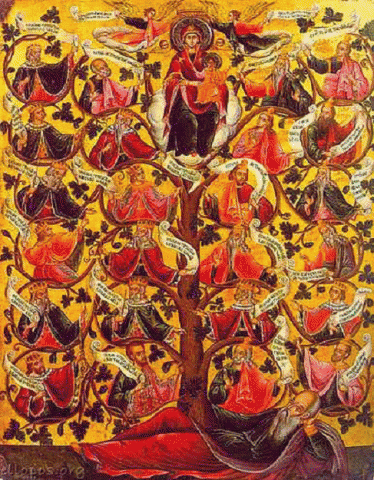
THE JESSE TREE
The idea for a Jesse tree comes from the Scripture referring to Jesus as being a tree from the root of Jesse. Jesse was the father of David, ancestor of Jesus both through Mary and through his adoptive father, Joseph. It was because of this ancestry that they were both traveling to Bethlehem for the census; Bethlehem was the city of David. Thus, the Jesse tree holds symbols of the ancestors, either physical or spiritual or both, of Jesus.
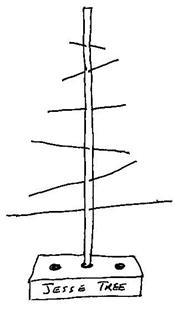 Traditionally, the Jesse tree is placed in the home at the beginning of Advent. For each day, the children add an “ornament” to the tree, one for each of 40 Old Testament saints and prophets. It is left up during the Christmas season as a reminder of the centuries God spent preparing a people for His coming.
Traditionally, the Jesse tree is placed in the home at the beginning of Advent. For each day, the children add an “ornament” to the tree, one for each of 40 Old Testament saints and prophets. It is left up during the Christmas season as a reminder of the centuries God spent preparing a people for His coming.
How to make a Jesse tree? I’ve seen both 3-D and 2-D versions. With a 3-D version, you could take either a small purchased Christmas tree or a bare sapling or tree branch that looks like a tree, or make one with dowels like we are doing this year with the 10-12-year-old class is Church School. Then, for each character, you make a 3-D ornament that symbolizes the 40 characters you have chosen – e.g., an apple for Adam, a rainbow for Noah, a camel for Abraham, etc. These can be made a simply as taking a regular Christmas ball and gluing on a picture or a sticker, or with a multitude of craft styles and skill levels. They can all be in the same style or in a vast array of styles; if you leave them up to the creativity of the children, they’ll be in a vast array of styles, but interesting!
 3-D version takes up too much space or too easy to knock over? Then make a felt banner with a large brown or black tree with lots of branches. Hang it on the wall and cut out felt shapes symbolizing the various characters and place them as if hanging from or sitting on the branches, one for each day. Using felt, you do not need Velcro unless the “ornaments” are particularly heavy. Some people get really fancy and needlepoint or embroider or stuff their ornaments; these will be heavy and need Velcro. No wall to hang it on and have to pack up the classroom each week? Draw your tree on one of those trifold display boards and use the paper ornaments. You can fancy them up by glueing to colored cardstock or foam ornament shapes or even Mod Podging to wooden ornament shapes easily purchased.
3-D version takes up too much space or too easy to knock over? Then make a felt banner with a large brown or black tree with lots of branches. Hang it on the wall and cut out felt shapes symbolizing the various characters and place them as if hanging from or sitting on the branches, one for each day. Using felt, you do not need Velcro unless the “ornaments” are particularly heavy. Some people get really fancy and needlepoint or embroider or stuff their ornaments; these will be heavy and need Velcro. No wall to hang it on and have to pack up the classroom each week? Draw your tree on one of those trifold display boards and use the paper ornaments. You can fancy them up by glueing to colored cardstock or foam ornament shapes or even Mod Podging to wooden ornament shapes easily purchased.
You don’t have children at home anymore? What more lovely gift to make for the grandchildren or godchildren than a Jesse tree complete with ornaments (or ornament kits) that they would enjoy year after year?
Here are some suggested readings to go with the Jesse Tree ornaments we are making in class. The ornaments we made in Church School are in normal print. But there are more days in Advent than we have weeks in Church School. The other characters in bold are discussed in the opening exercises and ornament is suggested that can be made at home very, very simply to finish the 40 days.
|
Reading |
Subject |
Ornament |
|
Genesis 1 and 2 |
Creation |
Paper creation ball |
|
Genesis 3 |
Adam and Eve |
Bead apple |
|
Genesis 5:18-24 |
Enoch |
White Hair |
|
Genesis 6:9-8 |
Noah |
Rainbow of beads |
|
Genesis 11:1-8 |
Tower of Babel |
Tower of toothpicks |
|
Genesis 12:1-8, 17:1-8, 18:1-15 |
Abraham |
Egg-carton Camel |
|
Genesis 21:1-6, 22:1-18, 24:1-17 |
Isaac |
Lamb on Fire |
|
Genesis 25: 21-34, chapters 27-29, 31:1-7, chapter 33 |
Jacob |
Macaroni Angel |
|
Genesis 37, Genesis 39-45 |
Joseph |
Many-colored Coat |
|
Exodus 2:1-3:21, 5:1-15, 12:21-36, all of 14, 19 and 20 |
Moses |
Clay tablets |
|
Numbers 22-24 |
Balaam |
Spool Donkey |
|
Joshua 2 |
Rahab |
Small Basket on Rope |
|
Joshua 2, 4, 6, 24:15 |
Joshua |
Gold Trumpet |
|
Judges 4 |
Deborah |
Horse |
|
Judges 6-7 |
Gideon |
Clay pot with Candle |
|
Judges 13-16 |
Samson |
Scissors with Long Hair |
|
Job 1 and 42 |
Job |
Egg Face |
|
Ruth 1:3-8, 6-19, 2:1-12, 4:9-11 |
Ruth |
Sheaf of wheat |
|
I Samuel 1, 2:18-20, 3 (whole chapter) |
Samuel |
Tunic on Hanger |
|
I Samuel 9:15-10:8, 13:1-15, 15:10-28 |
Saul |
Paper crown with jewels |
|
I Samuel 16-17, I Samuel 19:1-10, 20:12-42, II Samuel 4:4, 9:1-7, 15:10-14, 18:5-14, 33 |
David |
Leather Slingshot |
|
I Kings 1:32-37, chapter 3 |
Solomon |
Clay Temple |
|
I Kings 17:1-18:2, 18:17-46, II Kings 2:1-13 |
Elijah |
Feather Raven |
|
I Kings 22:1-47, II Chronicles 19 |
Jehoshaphat |
Harp or Cymbals |
|
II Kings 4:1-36 and chapter 5 |
Elisha |
Clothespin Naaman |
|
Jonah 1-3 |
Jonah |
Yarn Whale with Jonah |
|
Judith 8-13 |
Judith |
Doll’s Head |
|
Isaiah 6, 37:33-38:8, 39 |
Isaiah |
Fiery Coal |
|
II Chronicles 29, 30, 32 + Isaiah 36-38 |
Hezekiah |
Sun |
|
II Chronicles 34 and 35 |
Josiah |
Small Bible |
|
Jeremiah 13:1-11 and chapter 28 |
Jeremiah |
Felt Belt |
|
Ezekiel 1:1-28, 3:1-9, 37:1-14 |
Ezekiel |
Skeleton |
|
Daniel 3 |
3 Young Men in Fire |
Pipecleaner Men |
|
Tobit 2, 5-12 (shorten as needed) |
Tobit |
Tobias’s Fishing Rod |
|
Daniel 5 & 6 |
Daniel |
Lion |
|
Esther 5:1-8 and chapter 7 |
Esther |
Beaded Crown |
|
Daniel 22:33, Habakkuk 3:17-19, 2:20 and 3:3 |
Habakkuk |
Pot of Stew |
|
Micah 1:1-12, Micah 6:8 and Micah 5:2-4 |
Micah |
Soldier |
|
Nehemiah 2:1-6, 4:6-23, 8:1-9 |
Ezra and Nehemiah |
Scroll |
|
II Maccabees 5:11-27, 8:1-10:9 |
Judah Maccabee |
Hanukkah Candles |
RECIPES
CLAYS PAINTS
SALT DOUGH FINGER PAINT (4 WAYS)
2 cups flour Use pudding with food coloring!
1 cup salt Mix liquid starch and food coloring.
about 1 cup water Mix 3 T sugar, ½ cup cornstarch, and
food coloring 2 cups cold water. Cook over
bath oil, vegetable oil, peppermint oil low heat, stirring, till thick.
Mix flour and salt. Add water Pour into muffin tin. Add
slowly and mix with your fingers until food coloring to each cup.
it makes dough. Knead in a few drops
food coloring and a splotch of oil (if SAND PAINT
desired). Store in air-tight container. Add dry tempera paint to corn meal.
Sprinkle over areas “painted” with thinned glue
SELF-HARDENING CLAY
1 cup sand for sand effect. Shake off excess.
½ cup cornstarch
1 tsp powdered alum PASTES
¾ cup hot water PRIMARY PASTE
Food coloring if desired Mix ½ cup water and 1 cup flour
Mix sand, cornstarch and alum in a bowl. Spoon into a jar
in large pot. Add hot water and stir or squeeze bottle to store.
vigorously. Add food coloring if
desired. Cook over medium heat PAPIER MACHE PASTE
until thick, stirring constantly. 3 cups water
After cooling, store in airtight container. 1 ½ cups flour
Mix flour with cold water until lumps are gone.
SAWDUST CLAY
2 cups fine sawdust Dip strips of newsprint in paste and mold around
1 cup flour surface to be shaped. Air dry.
Water
Mix sawdust and flour in bowl
or bucket. Add a little water at a time,
stirring till it is stiff but pliable. Knead
till it’s elastic and easy to shape. Store
in airtight container. Air dry.
CORNSTARCH DOUGH
2 cups cornstarch
4 cups baking soda
2 ½ cups water
Mix cornstarch and soda in large
pot. Add water. Cook, stirring, over medium
heat until thick like mashed potatoes. After
cool, knead on wax paper for 5 minutes. Store
in an airtight container. Air dry.
Creation
THE CREATION
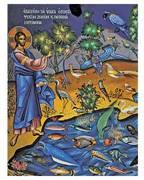
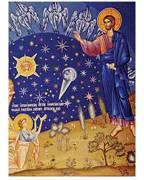 Objectives:
Objectives:
- Students should be able to tell the story of Creation and what was created on which day.
- Students should have a basic understanding of the creationist and evolutionary theories of creation.
Possible lesson plan:
- Open with prayer.
- Scripture Reference: Genesis 1 and 2. Read also God is With Us pages 5-7.
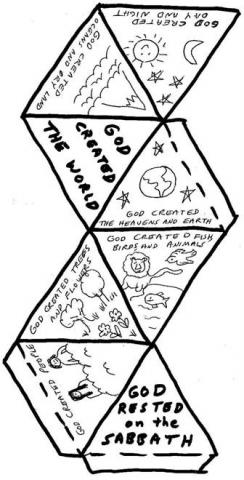 Learning Game: Missing Parts – Give each child a card with a number between 1 and 6 on it. Around the room, hide cards with the names of things God created on them, several for each day. The students should conduct a search for their “missing parts” – the things that were created on their day. Then have each student present his findings to the class. Were they right?
Learning Game: Missing Parts – Give each child a card with a number between 1 and 6 on it. Around the room, hide cards with the names of things God created on them, several for each day. The students should conduct a search for their “missing parts” – the things that were created on their day. Then have each student present his findings to the class. Were they right?
Day 1: light, darkness, day, night
Day 2: waters heaven,
Day 3: land, seas, trees, flowers
Day 4: sun, moon, stars
Day 5: fish, birds, sea monsters, sharks, whales
Day 6: cows, sheep, lions, elephants, toads, snakes, man
- Discussion: Creation is an unpopular belief today and students are subjected to the assumption that the theory of evolution is a fact. The Bible is very clear – Who created everything? How did life begin?
- Environmentalism however is very popular today; everyone worries about the rain forests. This is the first lesson of the new year; the first day of the new liturgical year is designated as environmental awareness day. Whom did God entrust with His creation? What responsibility do we have towards all living things? How, then, should we behave? Do you? What can be changed?
- Take the enclosed pattern and copy it on heavy paper, one per student. Color with markers and cut out. Fold and tape to make a diamond-shaped ornament.
- Close with prayer.
Adam and Eve and the Fall
ADAM AND EVE AND THE FALL

Objectives:
1. Students should identify Adam and Eve, the Holy Forefathers.
2. Students should be able to tell the story of the Fall.
3. Students should identify Satan, the snake, Lucifer, the fallen angel.
Possible Lesson Plan:
- Open with prayer.
- Scripture Reference: Genesis 3. Read also God is With Us pages 8-11.
- Learning Game: Skit – Have the students each take a role in the story: Adam, Eve, Satan, God. The rest can be animals. Have them re-enact the story as they remember it after reading it with you.
- Discussion: Who is Satan? What happened to Lucifer, the greatest of all angels? Why was he thrown out of heaven? Why did God create people? What excuse did Adam and Eve make for disobeying God?
- In the Canon of St. Andrew of Crete, which we recite during the first week of Great Lent, St. Andrew laments: “For failing to observe just one of Your commandments, O Savour, Adam was justly exiled from Eden. What then shall I suffer for continually ignoring Your words of life?” Why did Adam and Eve sin? Why did God let them? Do we ever disobey our parents? God? Why is it so easy to disobey when we know better? Why do we choose to disobey? What happens when we disobey? Do we also make excuses? What temptation did Adam and Eve face? What temptations do you face? What was the outcome of the story? What happened to Adam and Eve? What happens to us when we sin? If we “get caught”? If we don’t “get caught”?
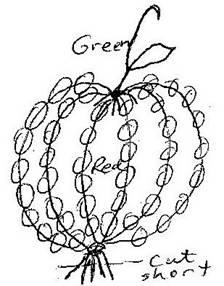
- Make a Bead Fruit: Each student should receive 6 red pipe cleaners, each cut in half, making 12 pieces. String 12 red beads onto each piece, leaving both ends clear. Line up all 12 beaded pieces and twist one end together. This is the upper part of the “apple”. Now bend each pipe cleaner around forming a ball with the twisted part in the center. Shape into a sphere and twist the other end together and cut short, forming the bottom. Take a short green pipe cleaner and form a leaf and twist it onto the top of the fruit, with one end bent as a hanger.
- Close with prayer. Have each student name a temptation common to their generation and all pray to obey God in that situation in the future.
Noah
NOAH
Objectives:
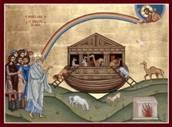 Students should be able to identify the three sons of Noah by name.
Students should be able to identify the three sons of Noah by name.- Students should identify the Great Flood and its significance.
- Students should know God’s meaning for a rainbow.
Possible Lesson Plan:
- Open with prayer.
- Scripture Reference: Genesis 6:9-8. A bit long but difficult to leave any part out. A summary is available in God is With Us, pages 12-16. How big was that ark after all? (about 450 feet: 1 cubit is about 18 inches). How long were they in the boat? (more than a year!) What was the meaning of the rainbow?
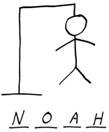 Learning Game: Hangman – Write on pieces of paper words or names important to this story: Noah, dove, rainbow, ark, Shem, Ham, Japheth. Each student in turn can draw a word and put the appropriate number of dashes, one for each letter, on the board. Students guess the letters; if the letter is in the word, the hangman writes it on the appropriate dash mark. If not, he draws the head of the hanged man. With each subsequent guess, he adds trunk, arm, arm, leg, leg. The object is to guess the word before the man is hanged.
Learning Game: Hangman – Write on pieces of paper words or names important to this story: Noah, dove, rainbow, ark, Shem, Ham, Japheth. Each student in turn can draw a word and put the appropriate number of dashes, one for each letter, on the board. Students guess the letters; if the letter is in the word, the hangman writes it on the appropriate dash mark. If not, he draws the head of the hanged man. With each subsequent guess, he adds trunk, arm, arm, leg, leg. The object is to guess the word before the man is hanged.
- Discussion: How do you think Noah felt building a huge boat in his back yard with all the neighbors laughing at him? Have people ever laughed at you? How did it feel? How did you respond? How did Noah respond?
 Make a rainbow: Each student should get half a white pipe cleaner, a variety of colored beads, and about 18 inches of “beading lace”, and 2 white cotton balls. Bend one end of the pipe cleaner to keep the beads from sliding off. You will see that the beading lace has large holes about 1/2 inch apart in the center. Push the pipe cleaner through the first hole, then thru a bead, then the next lace hole, then a bead, alternating until you reach the end of the pipe cleaner. Bend that end. Glue cotton balls (clouds) over the bent ends and tie a small string in the middle for a hanger.
Make a rainbow: Each student should get half a white pipe cleaner, a variety of colored beads, and about 18 inches of “beading lace”, and 2 white cotton balls. Bend one end of the pipe cleaner to keep the beads from sliding off. You will see that the beading lace has large holes about 1/2 inch apart in the center. Push the pipe cleaner through the first hole, then thru a bead, then the next lace hole, then a bead, alternating until you reach the end of the pipe cleaner. Bend that end. Glue cotton balls (clouds) over the bent ends and tie a small string in the middle for a hanger.
- Close with prayer. Pray for the courage not to be afraid to look silly in the eyes of men in order to obey God.
Tower of Babel
THE TOWER OF BABEL
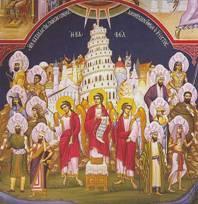 Objectives:
Objectives:
- Students should be able to identify the Tower of Babel and tell its story.
- Students should identify the source of the many languages we have today.
Possible Lesson Plan:
- Open with prayer.
- Scripture Reference: Genesis 11:1-8. This one would probably be easy to have each student read a verse going around the circle – short and sweet. Why did the people build the tower? Why did God confuse their languages?

- Learning Game: Language Bingo – Make bingo cards for each student with 5 languages across the top (English, Spanish, French, German, and Russian – or whatever you speak) and numbers between one and ten in the spaces; each card can be different. Now call the names of the numbers in the appropriate language and see if the students have any idea which space to mark! You can use the languages below, or those used in your own parish. Make up your own cards, or use the ones below
For reference:
Spanish: uno, dos, tres, cuatro, cinco, seis, siete, ocho, nueve, diez
French: un, deux, trois, quatre, cinq, six, sept, huit, neuf, dix
German: eins, zwei, drei, vier, funf, sechs, sieben, acht, neun, zehn
Russian: adeen,dvah,tree,chetiree,pyaht,shest,syem, vosyem, dyevyet, dyesyet
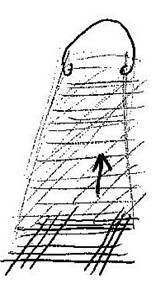 Discussion: Do you speak another language? Many of the children have no idea what it is like to not understand what someone is saying; indeed, travel to a foreign country is one of the only ways to bring this lesson home. But, give it a try. Begin the lesson in another language, or give the instruction for the crafts in another language. Watch the blank stares and discuss their reactions. Acting is not your thing? Don’t know a language? Discuss war! What similarities do all people share? Differences? What are some reasons for war? How do diplomats try to resolve these differences? How do cultural and language differences make resolving problems hard? What can we do to better understand people of a different culture and language?
Discussion: Do you speak another language? Many of the children have no idea what it is like to not understand what someone is saying; indeed, travel to a foreign country is one of the only ways to bring this lesson home. But, give it a try. Begin the lesson in another language, or give the instruction for the crafts in another language. Watch the blank stares and discuss their reactions. Acting is not your thing? Don’t know a language? Discuss war! What similarities do all people share? Differences? What are some reasons for war? How do diplomats try to resolve these differences? How do cultural and language differences make resolving problems hard? What can we do to better understand people of a different culture and language?
- Make a toothpick tower: Do these on a napkin or paper towel with lots of glue! Begin with 2 toothpicks parallel. Glue 2 more on perpendicular near the ends of the first 2. Now glue on 2 parallel to the first 2 near the ends of the second two. Keep going until the tower is the desired height; if you want, you can break the upper toothpicks, having the tower get narrower and narrower. Bend a pipe cleaner to make a hanger at the top.
- Close with prayer, adding a special prayer for any conflict going on in the world today.
Abraham
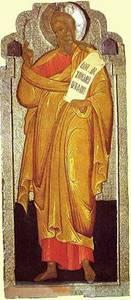 ABRAHAM
ABRAHAM
Objectives:
- Students should be able to tell the story of Abraham.
- Students should identify Abraham as the father of the Jewish people, chosen by God.
Possible Lesson Plan:
- Open with prayer.
- Scripture Reference: Genesis 12:1-8, 17:1-8, 18:1-15. As you read, follow his path on the map. Read also God is With Us pages 17-21.
- Learning Game: Pictionary. Give each student a scene from the story: Abraham leaving Haran, Abraham with the 3 men, Sarah laughing, etc. He should begin to draw his scene on the board, with the other students trying to guess which event in the life of Abraham is being depicted.
- Discussion: Abraham is held up in the New Testament as an example of faith. What did God ask Abram to do? What questions would you have had of God before selling everything and loading your camels? How did Abram become Abraham? Why did God give him a new name? Sometimes we take a new name at baptism. Why?
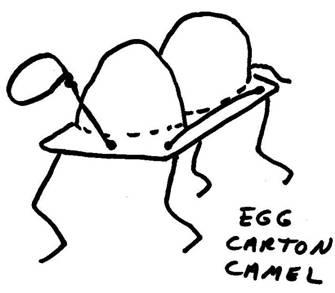
5. Make an Egg-Carton Camel:
Cut a 2-hump section from an egg carton.
Punch 2 holes on each side and one on each end.
Bend brown pipe cleaners through holes for legs, head
and tail.
Paint the body brown and let dry.
6. Close with prayer. Ask students to
name problems where faith is needed
and pray for these specifically;
alternately, take the prayer chain
list and pray for each need and person
on the list, trusting God to care for
that need.
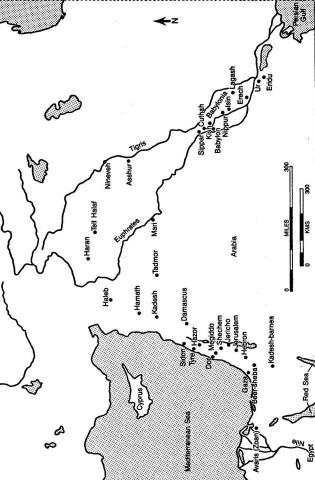
Isaac
ISAAC
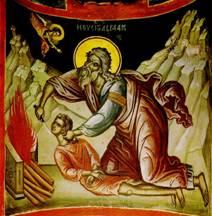 Objectives:
Objectives:
- Students should be able to tell the story of Isaac – his birth, the sacrifice on the mountain, and his marriage.
- Students should identify Isaac as the son of Abraham and Rebekah as his wife.
Possible Lesson Plan:
- Open with prayer.
- Scripture Reference: Genesis 21:1-6, 22:1-18, 24:1-17.
- Learning Game: Try a game of Password. Divide the students into 2 teams. Give one student a name from the story (e.g., Abraham, Sarah, Isaac, Rebekah, servant). That student must give one-word clues to his teammates; have a one-minute time limit and, if the name is not guessed, the other team gets a try. Then the other team gets its own word.
- Draw a family tree: Begin with Abraham and Sarah, add Isaac, then Rebekah. You can draw the student’s family trees as well to illustrate the process. Add Ishmael and Hagar also. What about Laban and Nahor and Milcah?
- Discussion: The family tree of Abraham is very important. From Isaac came the Jewish people; from Ishmael the Arabs. Discuss the relationship of Israel and the Palestinians to this day.
- Do the students remember the story from the Gospels of the Woman at the Well? Rebekah gave the servant water to drink because he was thirsty. When Christ asked the Canaanite woman for a drink from the well, He told he that He is the Living Water, whoever drinks it will never thirst. So, the water from Rebekah’s well in the Old Testament is just normal water – people drink from it and are thirsty again. But, Christ, the Light of the World, the True and Living Water, gives everlasting nourishment.
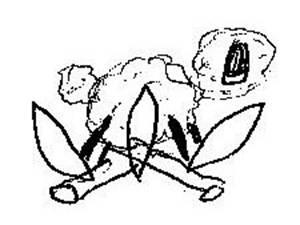 Make a “Sacrificial Lamb”: Cross 2 craft sticks as the firewood and glue. Shape a lamb made of a large, medium, and small white pompom glued together, with black felt ears and black pipe-cleaner legs. Cut out flames from orange, red, and yellow felt and glue lamb and flames onto the base. Tie a string for a hanger.
Make a “Sacrificial Lamb”: Cross 2 craft sticks as the firewood and glue. Shape a lamb made of a large, medium, and small white pompom glued together, with black felt ears and black pipe-cleaner legs. Cut out flames from orange, red, and yellow felt and glue lamb and flames onto the base. Tie a string for a hanger.
Close with prayer. Be sure to pray for the situation in Israel today.
Jacob
- JACOB
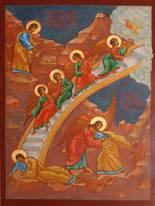 Objectives:
Objectives:
- Students should be able to identify and name “Abraham, Isaac, and Jacob”.
- Students should be able to tell the stories of Jacob and Esau, Jacob’s ladder, and Jacob and Rachel.
- Children should recognize “Israel” as the name God gave to Jacob, later to be the name of God’s chosen people.
Possible Lesson Plan:
- Open with prayer.
- Scripture Reference: Genesis 25: 21-34, chapters 27-29, 31:1-7, chapter 33.
- Learning Game: Try “The Big Step” – Students begin along the back wall of the classroom. Each is in turn asked a question; if he can answer the question, he gets to take as large a step as he can. If not, he loses that turn. Some questions for this chapter might be:
Who was Isaac’s first-born son?
Who sold his birthright for a pot of stew?
Who received Isaac’s blessing?
How did Jacob deceive Isaac into giving him the blessing?
Who was Rebekah’s brother?
Where did Laban live?
What did Jacob see on the ladder?
Who was Jacob’s first wife?
Who was Jacob’s favorite wife?
- Add Jacob and Esau to your family tree. Then add Leah and Rachel to Jacob.
Be sure to include Laban!
- Discuss lying and cheating: Did Jacob lie to Isaac to cheat Esau from his inheritance? Was this right? Was Esau happy with Jacob or angry? What about Laban to Jacob about Leah? How did Jacob feel? Have you ever lied? What about “little white lies”; can you think of a situation where lying is the right thing to do? Why or why not? Has anyone ever lied to you or about you? How do you feel? Have you ever cheated? At school? What happened when Jacob returned to the land of Esau? Retell the story of the Prodigal Son: How is this like the return of Jacob to his homeland?
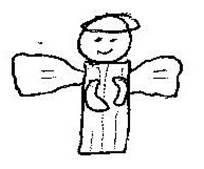
- Make a “Macaroni Angel”: Take a rigatoni for the body. Glue on a doll head and glue tiny pasta on for hair. Elbow macaroni make the arms and a bow tie the wings. Add a circle of gold pipe cleaner for a halo and she’s done! The pipe cleaner can double as hanger.
Close with prayer. Pray for the strength to speak and act truthfully all week.
Joseph #1
- JOSEPH #1
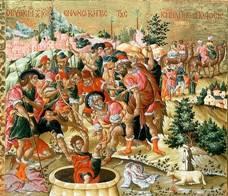
Objectives:
- Students should be able to name Joseph and his brothers as the 12 children of Israel.
- Students should be able to tell the story of Joseph and the many-colored coat and of Joseph sold into slavery.
Possible Lesson Plan:
- Open with prayer.
- Scripture Reference: Genesis 37.
- Learning Game: Try “Brother Concentration”. It may seem unimportant to know the names of all 12 brothers, until one realizes that they become the names of the 12 tribes of Israel. Write each of the 12 names twice on small pieces of paper and tack or tape to the board randomly in rows of 3 by 4. Cover each with a Post-It of similar size and write numbers from 1 to 24 consecutively on the cover papers. The students will guess 2 numbers; if they have the same name behind them, they get to continue. If not, put the Post-It back over the name and keep going.
- Add Joseph and his brothers (Reuben, Simeon, Levi, Naphtali, Issachar, Asher, Dan, Zebulon, Gad, Judah, and Benjamin) to the family tree; Joseph and Benjamin will be under Jacob and Rachel, the rest under Jacob and Leah.
- Discussion: Talk about a dysfunctional family! What is your favorite memory of family life? Least favorite? How would Joseph have answered that question? Who was at fault for the disastrous outcome in the pit? What part did Jacob play? Joseph? The brothers? How could each of them have changed his behavior to avoid the disastrous end in the pit? What about your least favorite memory? Who was involved? How could it have turned out differently and why didn’t it?
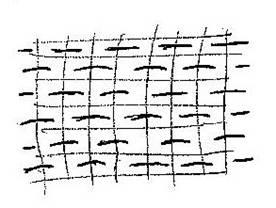 Weave a “Many-Colored Cloth”: Take a 5-inch square piece of onion bag (or similar mesh bag). Using varied colors of yarn, weave in and out of the holes in the mesh, alternating above and below to make a woven effect. Leave the ends of the yarn protruding about ½ inch on each side as fringe. Tie on a piece of yarn as a hanger.
Weave a “Many-Colored Cloth”: Take a 5-inch square piece of onion bag (or similar mesh bag). Using varied colors of yarn, weave in and out of the holes in the mesh, alternating above and below to make a woven effect. Leave the ends of the yarn protruding about ½ inch on each side as fringe. Tie on a piece of yarn as a hanger.
- Close with prayer. Pray for each student’s family and the relationships of parents and siblings.
Joseph #2
JOSEPH #2
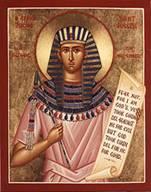 Objectives:
Objectives:
- Students should be able to tell the dreams of the butler, baker, and Pharoah.
- Students should know the story of Joseph’s forgiving his brothers.
- Students should know how the people of Israel came to live in Egypt.
Possible Lesson Plan:
- Open with prayer.
- Review the story of Joseph from last week.
- Scripture Reference: Genesis 39-45. There’s too much here, but ever single chapter is important. Have each student read a chapter silently and report on it to the class.
- Learning Game: Try the “Egg Carton Shake” – Take an empty egg carton. In each pocket write the name of an object from the story of Joseph:
grape colored yarn cow ears
basket signet ring scarf coin
caravan sheaf sun cup
Place a small button or coin in the egg carton. Each student in turn shakes the egg carton and has to tell the story of the object where the button landed. If he lands on a story already told, shake again!
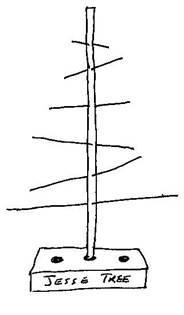 Discussion: Joseph had many things happen to him that were unfair. Can you name some of the times? How did Joseph act in each situation? Have you ever been treated unfairly? Do you try to get revenge or do you forgive as Joseph did? God turned something that was intended for evil toward Joseph into something that was good. Has God ever taken something that was intended for evil against you and made something good out of it? Joseph always worked hard and did his best to honor God. As a result, God blessed Joseph. How can you honor God?
Discussion: Joseph had many things happen to him that were unfair. Can you name some of the times? How did Joseph act in each situation? Have you ever been treated unfairly? Do you try to get revenge or do you forgive as Joseph did? God turned something that was intended for evil toward Joseph into something that was good. Has God ever taken something that was intended for evil against you and made something good out of it? Joseph always worked hard and did his best to honor God. As a result, God blessed Joseph. How can you honor God?
- Begin now on the Jesse trees themselves, since we don’t need two Joseph “ornaments”. Take a dowel or broomstick about 3 feet long for each student. Insert in a brick for a base. Cut a piece of felt to cover the base of the brick (to keep from scratching furniture) and paint or stencil the words “Jesse Tree” on the side of the brick in gold. Drill holes at 4-inch intervals in the large dowel for six 3/16-inch dowels 24, 20, 16, 12, 8, and 4 inches long (smallest on top), each hole at a 60-degree angle to the previous. Each small dowel should be drilled with a tiny hole every 2 inches for an “ornament”. Glue dowels in place and spray the whole tree gold. Another option would be to have each student collect a fallen tree branch that resembles a small tree, again spray gold, and insert in brick.
- Close with prayer. Have each student think of someone he needs to forgive and pray for God’s help in forgiving.
Moses #1 (early life)
MOSES #1
Objectives:
- Students should be able to tell the story of the baby Moses and his salvation on the Nile.
- Students should be able to tell the story of the burning bush.
Possible Lesson Plan:
- Open with prayer.
- Scripture Reference: Exodus 2:1-4:20. Story is also in God is With Us pages 22-25.
- Learning Game: Simon says “It’s True” – Line the students against the wall. As you read them a series of True or False statements, the students respond to your questions physically, as in:
If Pharaoh made a law that all newborn Hebrew boys must die, sit down.
If the soldiers killed Jochebed’s baby boy, scratch your head.
If Jochebed hid her son in a basket, touch your ear.
If Pharaoh’s daughter found the basket, touch your toes.
If Pharaoh’s daughter nursed Moses, stick out your tongue.
If Pharaoh’s daughter adopted Moses, put your elbow on your knee.
If Moses killed an Egyptian overseer, cover your eyes.
If Pharaoh did not want to punish Moses, kneel.
If Moses fled to the land of Midian, stand on one foot.
If Moses never married, put both hands on your nose.
If God spoke to Moses on Mt. Horeb, kneel.
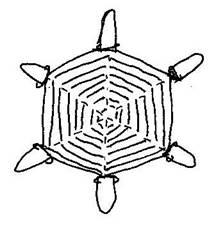 Discussion: It took great courage for Jochebed to give up her son. What might have happened if she had refused? God asked Moses to take His people out of Egypt; Moses knew this would be a hard thing to do. Has God ever asked you to do something you felt was hard? Moses was afraid to go to Pharaoh. What makes you afraid? Did Moses run away and hide in fear? What do you do when you are afraid?
Discussion: It took great courage for Jochebed to give up her son. What might have happened if she had refused? God asked Moses to take His people out of Egypt; Moses knew this would be a hard thing to do. Has God ever asked you to do something you felt was hard? Moses was afraid to go to Pharaoh. What makes you afraid? Did Moses run away and hide in fear? What do you do when you are afraid?
- Make the “Star of David” for the Jesse Tree: This will be made much like a “God’s Eye”. Take 3 craft sticks for each student and gold or yellow yarn. It’s easiest to glue the sticks together crossing in the middle to make 6 points early in class so they’ll be a bit dry when beginning to wrap the yarn. Glue down the end of the yarn and move around the star, wrapping the yarn around each of the 6 points in turn. Just keep going and going until there’s only an inch of each end showing. The ends can be painted gold (or spray them with the tree). Glue to top of tree.
- Close with prayer. Ask God to take away our fear. Pray for any specific fears the students have voiced.
Moses #2 (later life)
MOSES #2
Objectives:
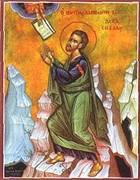 Students should learn the 10 plagues in order (all Jewish kids do!).
Students should learn the 10 plagues in order (all Jewish kids do!).- Students should memorize the 10 commandments.
- Students should be able to name Moses as the writer of the books of the Torah, the first 5 books of the Old Testament, and to name them.
- Students should be able to identify the Ark of the Covenant and tis contents: The Ten Commandments, Aaron’s rod that budded, golden pot of manna
Possible Lesson Plan:
- Open with prayer.
- Scripture Reference: How about Exodus through Deuteronomy? There is a summary in God is With Us pages 26-34. Overwhelming? Have the students read these passages in this order:
Exodus 5:1,2,7,8 Exodus 9:10-12 Exodus 14:10-16
Exodus 7:10-12 Exodus 9:22-24 Exodus 16:13-15
Exodus 7:20-21 Exodus 10:13-15 Exodus 20:1-18
Exodus 8:1-3 Exodus 10:21-23 Exodus 24:15-18
Exodus 8:21-23 Exodus 12: 21-23 Exodus 32:15-21
Exodus 9:2-5 Exodus 12:29-32 Exodus 34:1
- Learning Game: Name the Order. Write these events on cards and see if the
students can put them in order:
Moses found by Pharaoh’s sister Egyptian beating Hebrew
Moses cast out of Egypt Moses at Jethro’s well in Midian
Moses married Zipporah The burning bush
I am Who I Am Bricks without straw
Nile into blood Frogs
Gnats Insects
Cattle disease Boils and sores
Hail like fire Locusts
Darkness over the land Passover
Parting of the Red Sea Death of Pharaoh’s army
Manna Mt. Sinai
10 Commandments Golden Calf
NOW: Find them all on the map! Follow the path of Moses and the Israelites.
- Discussion: First look at Moses and Pharaoh – Why was Pharaoh so arrogant? Why was Moses so persistent? Has persistence ever helped you? In athletics? In school? List the situations. Did you ever give up and quit? What did you learn from each experience? What does faith have to do with persistence? For Moses? For you?
Now look at the 10 commandments – Which one seems most important? Least? Why did God give Israel laws? Which is hardest to keep and why?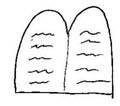
- Make a “Stone Tablet”: Shape a tablet out of silver or gray oven-fired clay. Engrave it with 10 lines of “writing”. Use a sharp point to make a small hole in the center. Bake the clay according to the directions. When cool, thread a string through the hole to hang it.
- Close with prayer. Pray for the persistence that leads to success, especially in those areas the students named earlier.
Balaam
BALAAM
Objectives:
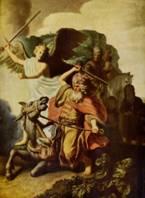 Students should be able to tell the story of Balaam and the donkey.
Students should be able to tell the story of Balaam and the donkey.- Students should understand the importance of obedience to God.
Possible Lesson Plan:
- Open with prayer.
- Scripture Reference: Numbers 22-24.
- Learning Game: Who Am I? Divide into 2 teams. The teacher picks a character from the story and begins to give clues, beginning with the hardest. For example, for Balaam, you might give lives near the river, son of Peor, rides a donkey, speaks for God, etc. After each clue, pause a moment to let the teams guess if they can. The first team to guess the identity of the character gets the point.
- Discussion: Talk about angels – what are they? Where have they appeared in the Bible? What are they doing? Who in the Bible has seen one? Anyone in the class seen one? Who is Lucifer? What’s his name now? What was his sin? Why was he thrown from heaven?
What about prophets? What is their role? (They speak for God.) What did Balak want? Why couldn’t Balaam oblige? What did God want from Balaam? (obedience) Did Balaam obey? Did he want to? What about you? Do you always obey God? Your parents? Do you always want to?
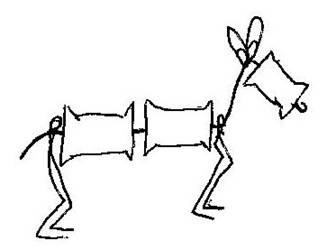 Make a Spool Donkey: Paint 3 spools for each student gray. Take 4 gray pipe
Make a Spool Donkey: Paint 3 spools for each student gray. Take 4 gray pipe
cleaners. One will be the main body; thread 2 spools to near one end (the tail). Wrap another pipe cleaner around the body for rear legs and shape them. Wrap another around the other end of the body for the front legs. Take the remaining half of the body pipe cleaner and bend it upward for a neck. Use half a pipe cleaner to make the ears, then add the head spool and bend the pipe cleaner down to keep the head from falling off. Decorate with eyes, nose, etc., with markers.
- Close with prayer. Pray to hear the voice of the Lord and obey (even if it takes a flaming angel and a donkey to get our attention!).
Joshua
JOSHUA
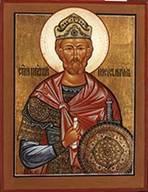 Objectives:
Objectives:
- Students should be able to identify Joshua as Moses’s successor.
- Students should be able to tell the story of the battle of Jericho.
- Students should identify Joshua as the person who said, “As for me and my house, we will serve the Lord.”
Possible Lesson Plan:
- Open with prayer.
- Scripture Reference: Joshua 2, 4, 6, 24:15; We have already met Joshua. Where? He was one of the spies sent by Moses to report about the Promised Land. Of the twelve spies, only Joshua and Caleb believed God could give the Israelites this land; the rest were afraid and wanted to turn back to Egypt!
- Learning Game: Relay Race. There are several events that occur in this chapter that can be re-enacted – the escape from Rahab’s roof, the crossing of the Jordan, and the defeat of Jericho. Line the class up in 2 teams. Place a chair about 1/3 of the way to the other side of the room in front of each team. Put a pile of 12 stones at the starting line and a trumpet or noisemaker at the end. Each contestant in turn must grab a stone, climb over Rahab’s wall (the chair), put his stone in the river (next to the trumpet), blow the horn, and run back to tag the next player. The game is over when one team deposits all its stones in the Jordan and the last player returns home.
- Discussion: Canaan contained many city-states, each with its own king. They were not about to let the Hebrews take their land without a fight! Why did Joshua feel he had to take the land? Do you think he got tired? How do we decide what’s worth fighting for? Do we ever get tired of fighting battles? What kind of battles do we fight?
A well-known verse from the book of Joshua is Joshua 24:15. Here Joshua is speaking for his entire household. If you were speaking for your household, whom would you serve? How can you tell whom Joshua served? How about you?
- Make a “Joshua Trumpet”: Take a trumpet-shaped plastic horn. Cover with gold paper and attach a string hanger. This one’s really easy, but pretty on the gold tree.
- Close with prayer. If any student mentioned something worth fighting for earlier, pray for that issue or need now.

Judges/Gideon
JUDGES/GIDEON
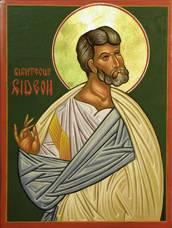 Objectives:
Objectives:
- Students should be able to tell the story of Gideon – the meat offering, the fleece, the choosing of the men, and the battle.
- Students should understand the need to trust in God in all things.
Possible Lesson Plan:
- Open with prayer.
- Scripture Reference: Judges 6-7. When the Israelites entered the Promised Land, they were not ruled by a king but by judges appointed by God. God had commanded Moses to build the Ark of the Covenant (remember what was in it?) and the Tabernacle – a huge tent, greatly decorated, holding the precious Ark. During the years of wandering, the Levites carried this huge tent and all of its furnishings, to be set up at each new camping place. In the Promised Land, the Tabernacle was set up at a place named Shiloh. The people came to Shiloh to pray and to give offerings to God. On the Day of Atonement each year, the high priest would sacrifice a goat as an offering to the Lord and send another goat out into the wilderness to show that the people’s sins were sent far away. On this holy day, celebrated from the days of Moses until today, the Jewish people fasted and prayed.
- Learning Game: Charades. Write the major events of the story on slips of paper (same as for the story-spinner below). Have the students pick out a slip and act out the event while the others guess what’s happening.
- Discussion: Gideon was one of the judges called by God. How did God call Gideon? How does He speak to you? What was the purpose of the fleece? How did Gideon choose his men? Why? How did he win the battle? Was Gideon stupid to go into battle with such odds against him? Why or why not? Have you ever faced seemingly impossible odds? Are there any conclusions we can draw from Gideon’s life about God’s work in our own lives?
- Find each of the tribes of Israel on the map. Where was Gideon? Other judges?
- Make a coil pot with a candle:
 Take self-hardening clay (not flammable). Flatten a ball of clay into a base. Make long snakes of clay and coil into a pot. Using a needle or paperclip, poke two small holes near the top for later insertion of a hanger. Put a tea-lite candle inside and let it dry.
Take self-hardening clay (not flammable). Flatten a ball of clay into a base. Make long snakes of clay and coil into a pot. Using a needle or paperclip, poke two small holes near the top for later insertion of a hanger. Put a tea-lite candle inside and let it dry.
- Close with prayer. Pray for strength against any “impossible odds” the students earlier listed.
Job
JOB
 Objectives:
Objectives:
- Students should be able to tell the story of Job – his losses and his struggle with Satan.
- Students should know that Job did not curse God.
Possible Lesson Plan:
- Open with prayer.
- Scripture reference: the book of Job. Instead of reading the whole book in class, an impossible task, try a summary reading. Assign the parts of Lord, Satan, Job, Eliphaz, Bildad, Zophar, and Elihu. The teacher can be the narrator. Have the appropriate student read these passages in this order to summarize the book:
Narrator – 1:1-4, 6 Lord – 2:2a Bildad – 18:2-4
Lord – 1:7a Satan – 2:2b Job – 19:1-7, 21-22
Satan – 1:7b Lord – 2:3 Zophar – 20:4-9
Lord – 1:8 Satan – 2:4-5 Job – 27:5-6
Satan – 1:9-11 Lord – 2:6 Narrator – 32:1-6
Lord – 1:12 Narrator – 2:7,11-13 Elihu – 33:8-28
Narrator – 1:13-20 Job – 12:4 Lord – 38:1-12,40:1-2
Job – 1:21 Eliphaz – 15:12-16 Job – 40:3-5
Narrator – 1:22, 2:1 Job – 16:1-3 Lord – 40:7-14
Job – 42:1-6
End with everyone reading Job 42:10-12
- Learning Game: Quotations – Write several well-known quotes from Job on index cards. Now tear each card in half and hide one half around the room before class. After reading the Scripture, give each student a card and see if he can find the other half.
Cut out quotes:
Job:1:8 “Have you yet considered my servant Job….
since there is none like him on the earth?”
Job 1: 21 “Naked I came from my mother’s womb, and naked shall I return…
The Lord gave and the Lord has taken away. Blessed be the name of the Lord.”
Job 5:13 “He catches the wise in their craftiness….
and subverts the counsel of the cunning.”
Job 5:17-18 “Blessed is the man whom God corrects…
For He causes a man to be in pain, but He restores him again.”
Job 13:15 “Though the Mighty One should lay His hand upon me….
I will speak and reason before Him.”
Job 13: 26,28 “For You wrote evil things against me and have watched all my works….
which have become old like a wineskin or like a moth-eaten garment.”
Job 17:15-16 “Where then is my hope, or where shall I see my good things?....
Will they go down with me to Hades, or shall we go down together in the tomb?”
Job 19:25 “I know that my Redeemer liveth….
and that He shall stand at the latter day upon the earth.”
Job 24:1-2 “Why have the times escaped the Lord’s notice?,,,
Why have the ungodly stepped over the boundary, snatching away the flock with the shepherd.”
Job 38:4,6 “Where were you when I laid the foundations of the earth?
To what were its foundations fastened, or who laid its cornerstone?”
Job 42: 3 “Who is he who hides counsel from You? …
Who will tell me what I knew not, Things too great and wonderful, which I did not know?”
Job 42: 5 “I have heard of You by the hearing of the ear…
but now my eye sees You.”
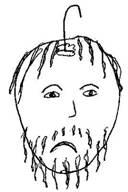 Discussion: Job centers on suffering. What did Job suffer? Who caused his suffering? Why did he suffer? Did that mean he was a bad man? Did his friends help him? How or how not? How would you have felt if they’d been your friends? Why did Job decide he wanted to die? Was that a good decision? Why or why not? List some forms of suffering today or some people or groups of people who are suffering on the board. Why is there so much suffering in the world? How could God allow this suffering? What can we do to bring hope to those who suffer? What is the worst suffering you have experienced? How did you survive?
Discussion: Job centers on suffering. What did Job suffer? Who caused his suffering? Why did he suffer? Did that mean he was a bad man? Did his friends help him? How or how not? How would you have felt if they’d been your friends? Why did Job decide he wanted to die? Was that a good decision? Why or why not? List some forms of suffering today or some people or groups of people who are suffering on the board. Why is there so much suffering in the world? How could God allow this suffering? What can we do to bring hope to those who suffer? What is the worst suffering you have experienced? How did you survive?
- Make a “Job Egghead”: Take a raw egg for the head. Poke holes in both ends and blow over a bowl until the egg is emptied. Decorate a sad face with markers, yarn, etc. Use half a pipe cleaner in the upper hole for a hanger. Leave the egg on its “chin” in an egg carton for a week to drain; wipe clean.
- Close with prayer. Pray specifically for those who are suffering that the students listed.
Ruth
RUTH

Objectives:
- Students should be able to tell the story of Ruth.
- Students should know that Ruth was from the tribe of Moab, not Israel. The Moabites were the descendants of Lot, Abraham’s nephew.
- Students should know that Ruth was a direct ancestor of Jesus.
Possible Lesson Plan:
- Open with prayer.
- Scripture Reference: Ruth 1:3-8, 6-19, 2:1-12, 4:9-11. Remember that the Moabites were the descendants of the son of Lot, the nephew of Abraham.
- Learning Game: Matching Game. Give each student a set of index cards, on which are written the names of the major characters in the story: Ruth, Naomi, Boaz. In the pattern of Final Jeopardy, give a single clue out loud. Each student is to hold up the card of his answer and gets 10 points if right.
- Discuss the customs of marriage – in ancient Israel and today. Why did Ruth stay with Naomi? What is the role of the mother-in-law, then and now? How did Ruth meet Boaz? Why was Ruth in the fields? What custom made Boaz Ruth’s husband? How do we choose a husband today? Who cares for the widow and the elderly today? List the positive qualities of Ruth, of Naomi, of Boaz. Was Ruth the sort of person who did things to be noticed? Did she seem to have a lot to offer – win any battles, heroic acts? Why is it important that Ruth became an ancestress of Jesus?
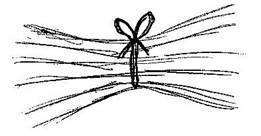
- Make a sheaf of “wheat”: Take the straw provided, a bundle about 5-6 inches long for each student. Tie in center with ribbon; ribbon end will be the hanger.
- Close with prayer. Pray for the students to exhibit the positive characteristics of Ruth, Naomi, and Boaz.
Hannah/Samuel
HANNAH/SAMUEL
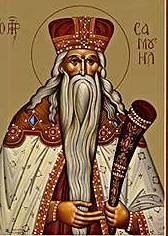
Objectives:
- Students should be able to tell the story of Samuel’s birth and his childhood in the temple.
- Students should understand that God spoke to Samuel and called him to his life work, and He will do the same for us.
Possible Lesson Plan:
- Open with prayer.
- Scripture Reference: I Kingdoms/I Samuel 1, 2:18-20, 3 (whole chapter).
- Learning Game: Jeopardy. Make 3 categories: People, Things, Numbers
People: Samuel, Eli, Hannah, Elkanah
Things: Robe, Bull, Ark, Temple
Numbers: Two (sons of Eli), Four (times God called), 12 months (new robe), Three (how old Samuel was)
Students choose a category and number from 1-4 and have to come up with a question to go with the answer. If they cannot, play passes to the next student.
- Discussion: Discuss other mothers and sons from the Bible: Sarah and Isaac, Rebekah and Jacob. Review their stories. Who else was old and prayed for a son? Do you remember the stories of Anna and baby Mary, Elizabeth and John, and Mary and Jesus from the New Testament? Who else gave her child to be raised in the temple?
Samuel is known as the last of the judges and the first of the prophets. What is a prophet? A prophet is a person called by God to deliver His message to His people.How did God speak to Samuel as a boy? How does He speak to us? Did Samuel know immediately that it was the Lord speaking? How did he find this out? How can we tell if God is speaking to us?
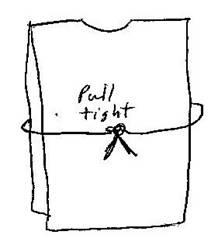
- Make a “Tiny Tunic”: Take a small rectangle of fabric. Fold in half and cut hole for head. Use piece of yarn or ribbon for the belt. Make a tiny hanger of pipe cleaner just like a clothes hanger if you want.
- Close with prayer. Ask God to speak to the students and to guide their lives.
Saul
SAUL
Objectives:
- Students should be able to identify Saul and the first king of Israel and Samuel who anointed Saul.
- Students should know the story of Saul’s disobedience to God.
Possible Lesson Plan:
- Open with prayer.
- Scripture Reference: I Kingdoms/I Samuel 9:15-10:8, 13:1-15, 15:10-28.
- Learning Game: 20 Questions. Put the names Saul, Jonathon, Samuel, Benjamin, and Philistines in a hat. Have a student draw one. The other students will ask “yes” or “no” questions until they identify the person. Benjamin is included because he was the son of Israel to whose tribe Saul belonged.
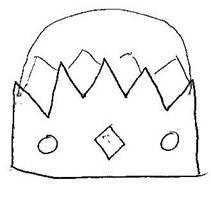 Discuss forms of government: How is our country governed? How was Israel governed in its early years? (with prophets and judges chosen by God for a specific task) Who were some of the people God used to lead His people? (Abraham, Joseph, Moses, Joshua, Gideon, etc.) Review their stories briefly. Why would people want a king? Did other countries have kings? Is it easier to trust a good-looking king or to trust the invisible God? What was Saul’s downfall? Samuel said to Saul, “to obey is better than sacrifice”. What does that phrase mean? Why does God prefer obedience to sacrifice?
Discuss forms of government: How is our country governed? How was Israel governed in its early years? (with prophets and judges chosen by God for a specific task) Who were some of the people God used to lead His people? (Abraham, Joseph, Moses, Joshua, Gideon, etc.) Review their stories briefly. Why would people want a king? Did other countries have kings? Is it easier to trust a good-looking king or to trust the invisible God? What was Saul’s downfall? Samuel said to Saul, “to obey is better than sacrifice”. What does that phrase mean? Why does God prefer obedience to sacrifice?
- Make a king’s crown for the Jesse Tree: Cut a crown shape out of heavy gold paper. Decorate with sequins, etc. Use a piece of string or thread as a hanger.
- Close with prayer. Pray for our government and rulers.
David (to Goliath)
DAVID (to Goliath)
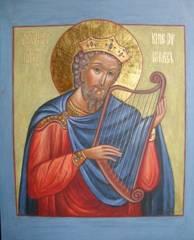 Objectives:
Objectives:
- Students should know the story of David – his anointing, his shepherd childhood, and the story of David and Goliath.
- Students should identify David as the author of many of the Psalms.
- Students should memorize the 23rd Psalm.
Possible Lesson Plan:
- Open with prayer.
- Scripture Reference: I Kingdoms/I Samuel 16-17.
- Learning Game: What’s in the Bag? – Make up ahead of time several lunch bags with items from the story of David in them: a stone, a harp, a sheep, a spear, a piece of bread, some oil, a lion (plastic or stuffed or just a picture). Give each student a bag and have him tell a story about David based on what he finds in his bag.
- Discussion: Goliath is described in the Bible as a descendant of the “giants”. Giants??? There is archeological evidence in Gath (Goliath was from Gath), Monash, and Megiddo of huge weapons and scales from huge body armor. Do you think David was afraid when he faced Goliath? Have you ever been afraid? List some things that frighten you. How did David deal with his fear? You? David proved that it doesn’t matter how old you are, you can do many things with God on your side! Can you think of some things you can do right now to please God?
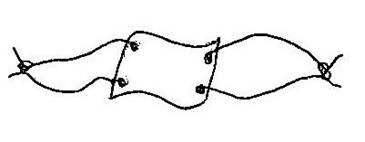 Make a slingshot for David. Take a small rectangular piece of leather and punch a hole in each corner. Use suede leather lacing to make the straps, about 12 inches for each side and knotted at the end after lacing through the two holes. The slingshot can hang from one of its straps.
Make a slingshot for David. Take a small rectangular piece of leather and punch a hole in each corner. Use suede leather lacing to make the straps, about 12 inches for each side and knotted at the end after lacing through the two holes. The slingshot can hang from one of its straps.
- Close with prayer. Pray for the courage to face fear head-on and defeat it, as did David.
David (later life)
DAVID AND JONATHON
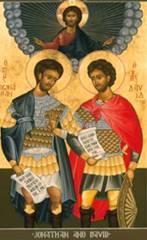 Objectives:
Objectives:
- Students should identify David as king after Saul and Jonathon as Saul’s son.
- Students should be able to tell the story of David and Jonathon and to name Jonathon’s son Mephibosheth and one of David’s sons, Absalom.
Possible Lesson Plan:
- Open with prayer.
- Scripture Reference: I Kingdoms/I Samuel 19:1-10, 20:12-42, II Kingdoms/ II Samuel 4:4, 9:1-7, 15:10-14, 18:5-14, 33. Be sure to review context with these disparate pieces of Scripture – how Saul had started out well but lost God’s favor through disobedience, David living with Saul and his family in order to play the harp to soothe the king to sleep, the friendship of David and Jonathon, the many years after his anointing by Samuel that David was a hunted man, the final death of Saul and Jonathon in battle, the triumphant entry of David into Jerusalem with the Ark of the Covenant, the kindness of David to Mephibosheth, the crippled son of Jonathon, and the treachery of David’s most beloved son, Absalom, and his death at the hand of Joab, general to David (and previously Saul).
- Learning Game: Look around the Room. Give each student a list of clues. Scatter around the room, cards with the names on them. Each student must hunt for the match for each question and write the answer on his page of clues. Be sure to leave the name cards in place for the next person to find!
Samuel – a boy prophet who grew up to anoint Saul and David
Saul – thought that sacrifice was better than obedience
Jonathon – Saul’s son who became David’s best friend
Jesse – father of David
Eliab – David’s oldest brother
Goliath – Philistine who defied the armies of God
David – carried corn and bread to his brothers on the battlefield
Amalekites – the land and people Saul was to destroy but did not
Mephibosheth – Jonathon’s crippled son, befriended by David
Absalom – David’s son who tried to steal his kingdom
Joab – general to David
- Discuss friendship: What is a friend? Who are your friends? What qualities make a good friend? Was Jonathon a good friend to David? Are you a good friend to your friends? What about David to Mephibosheth?
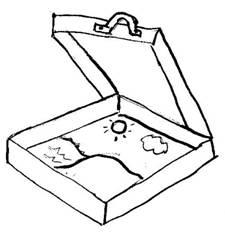 No need for another David ornament for the Jesse tree. So let’s have some fun with a Flannelboard Box: Take a pizza box for each student. Use green and light blue felt for the background on the inside of the box. Make felt figures of David, Saul, Goliath, Samuel, Jonathon, Jesse, Mephibosheth, Absalom, and Joab and appropriate felt scenery (tree, sheep, rock, tent, arrow, etc.) Put a handle on the box and title it “Stories of David” on the outside. Use it to tell the stories to younger children.
No need for another David ornament for the Jesse tree. So let’s have some fun with a Flannelboard Box: Take a pizza box for each student. Use green and light blue felt for the background on the inside of the box. Make felt figures of David, Saul, Goliath, Samuel, Jonathon, Jesse, Mephibosheth, Absalom, and Joab and appropriate felt scenery (tree, sheep, rock, tent, arrow, etc.) Put a handle on the box and title it “Stories of David” on the outside. Use it to tell the stories to younger children.
- Close with prayer. Pray that we will become better friends, as was Jonathon.
Solomon
SOLOMON

Objectives:
- Students should identify Solomon as David’s younger son.
- Students should know that Solomon chose wisdom as his gift from God.
- Students should know that Solomon built the great temple in Jerusalem.
Possible Lesson Plan:
- Open with prayer.
- Scripture Reference: 3 Kingdoms/I Kings 1:32-37, chapter 3.
- Try a Word Jumble:
1. God allowed me to build His temple. MONSOLO
2. I am a prophet who gave David and Solomon good advice TANANH
3. I am the father of Adonijah and Solomon. VIDAD
4. I am the city that Solomon lived in. RSLMEJEUA
5. I am the priest who crowned Solomon king of Israel. KOZAD
6. I am what Solomon asked God to give him. SIDMWO
7.Two women brought me before Solomon. YABB
8.We are the people who fought against Israel for many years. LNIEIPIHSTS
- Discussion: Who was Solomon’s father? His mother? What was the Ark of the Covenant? What did it contain? To whom did God give instructions for its construction? How had the people worshipped before they had a temple? Why did God not allow David to build the temple? Why would God have Solomon build a temple? What are the pros and cons to having a religious building for worship?
- For the Jesse Tree, model Solomon’s Temple: Use air-drying clay to make a small replica of the temple; you can use the Scriptural description or the picture below. Poke a hole through a window on each side for later placement of hanging string. After at least 24 hours drying, spray the entire temple gold.
6. Close with prayer. Pray for our church and its members.
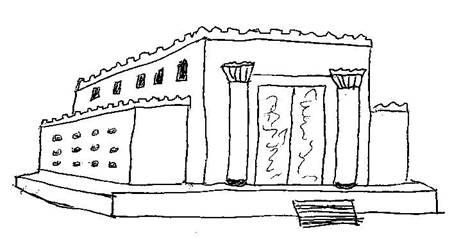
P
Proverbs and Song of Songs
PROVERBS AND SONG OF SONGS
Objectives:
- Students should identify Solomon as the author of these books and also Ecclesiastes.
- Students should identify Proverbs as a book of wise sayings.
- Students should identify Song of Songs as a love poem of Solomon.
Possible Lesson Plan:
- Open with prayer.
- Scripture Reference: Proverbs 1 and Song of Songs 1. Have students look these two chapters and compare and contrast their style and content. Historically, Solomon is known for his wisdom and his wives; the wives finally got him in trouble with God and the kingdom was divided after the death of Solomon. Solomon’s great love was the Queen of Sheba from today’s Ethiopia. They were married and had a son, but the queen took their son back to Ethiopia to rule. This son of Solomon and the Queen of Sheba began a dynasty that was to last longer than any dynasty in the history of man – ruling in Ethiopia until the death of Emperor Haile Selassie in the late 1900s.
- Learning Game: Scavenger Hunt – Divide into teams of about 3 students and give each team a bag and a list of the references from Proverbs. They should find the thing mentioned in the verse and put it in their bag. First team to find all wins.
Proverbs 3:3 – “write them on the _______ of your heart.” (tablet)
Proverbs 17:3 – “the refining _____is for silver” (pot)
Proverbs 9:17 – “_____eaten in secret is pleasant.” (bread)
Proverbs 15:17 – “better a dish of ____where love is” (vegetables)
Proverbs 30:19 – “a serpent on a ______” (rock)
Proverbs 23:31 – “when it sparkles in the _____” (cup)
Proverbs 27:21 – “the furnace for _____” (gold)
Proverbs 10:26 – “like _____to the teeth” (vinegar)
- Discussion: Discuss different types of love – love parents for children, love between friends, love between a man and a woman, love of God. How are these alike? How different? Discuss the two greatest commandments, according to Jesus – “Thou shalt love the Lord thy God…” and “thy neighbor as thyself”. How did Jesus answer the question about “Who is my neighbor?” Review the story of the Good Samaritan. Who is your neighbor? Who is in need of your love as a neighbor?
- No need for the Jesse Tree today so let’s make a Valentine… for God? For one of His children in a hospice or orphanage or hospital? Use red and pink paper hearts, doilies, stickers, etc. Who’s going to deliver them and to where?
- Close with prayer, praying especially for those neighbors named during class.
Elijah
ELIJAH
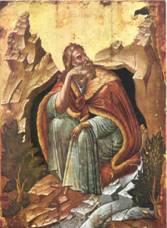 Objectives:
Objectives:
- Students should be able to tell the story of Elijah – his feeding by the ravens, the widow of Zarephath, his confronting the prophets of Baal, and the fiery chariot.
- Students should identify Ahab and Jezebel as an evil king and queen of Israel.
- Students should identify Elijah’s student and disciple, Elisha.
Possible Lesson Plan:
- Open with prayer.
- Scripture Reference: 3 Kingdoms/I Kings 17:1-18:2, 18:17-46, 4 Kingdoms/II Kings 2:1-13. This would be the time to discuss with the students the split among the Jewish people that occurred around 900 BC, dividing the land into Israel in the north with its capital of Samaria and Judah in the south with Jerusalem its capital. Elijah lived in the north and Ahab and Jezebel were king and queen of Israel. I have included an outline of the Kings and Prophets of the 2 kingdoms; refer to them as often as you have need. This is a very confusing time in the history of the Jewish people!
- Learning Game: Egg Carton Jumble – Take an empty egg carton. In each of the pockets, write the name of something from the story. Place a small button or pebble in the egg carton and close it. Let each student in turn shake the egg carton and open it. He must tell the story of the word where the button has landed. Pass to the next student. If the button lands on a word already used, take another turn.
Chariot mantle raven rain bread son
Baal Mt. Carmel fire prophet Ahab altar
- Discussion: Elijah was a prophet of God. What is a prophet? He spoke the words God gave him to say. Many times those words did not make the hearer very pleased. Who else had to say things for God that did not please his audience? (Balaam, Samuel). Review their stories. What are the differences between a prophet of God and a prophet of Baal? Would you have been willing to go to the king if you had been in Elijah’s place? Why or why not? Elijah was willing to stand up for what he believed in. What happened? Have you ever had to stand up for what you believe in? What happened?
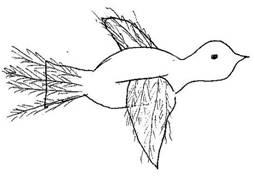
- Make “Elijah’s Raven”: Cut wings and bird body from black poster board. Slip wings through slit in body. Use black feathers to decorate. Draw in the eyes and a tiny piece of orange felt can be the beak.
- Close with prayer. Pray for the strength to stand up for what we believe in.
References for a confusing time in Jewish History:
KINGS AND PROPHETS
DATES KING OF ISRAEL KING OF JUDAH PROPHETS OTHER KINGS
-----------------------------------------------------------------------------------------------------
933BC Death of Solomon; division into northern and southern kingdoms Ahijah Shishak (Egypt)
933 BC Jeroboam (22 years) – Bad Rehoboam (17 years) – bad Shemaiah
915 BC Abijah (3 years)–bad mostly
912 BC Asa (41 years) – good
911 BC Nadab (2 years) – bad
910 BC Baasha (24 years) – bad
900 BC Rise of Assyria to world power Assur-nasipal II
887 BC Elah (2 years) – bad
886 BC Zimri (7 days) – bad
886 BC Omri (12 years) – horrible
875 BC Ahab (22 years) – the worst Elijah Shalmaneser II
874 BC Jehoshaphat (25 yrs.)–good Ben-hadad (Syria)
855 BC Ahaziah (2 years) – bad Elijah Mesha (Moab)
854 BC Joram (12 years) – bad mostly Elisha Hazael (Syria)
850 BC Jehoram (8 years) – bad
843 BC Jehu (28 years) – bad mostly Ahaziah (1 year) – bad Elisha
843 BC Athaliah (6 years) – horrible
843 BC Joash (40 yrs.)-good mostly Joel
820 BC Jehoahaz (17 years)—bad
806 BC Joash (16 years) – bad
803 BC Amaziah (29yrs)–gd mostly
790 BC Jeroboam II (41 years)-bad Jonah
787 BC Uzziah (52 years) – good Amos
749 BC Jotham (16 years) – good Hosea
748 BC Zechariah (6months) – bad Isaiah
748 BC Shallum (1month) – bad Micah
748 BC Menahem (10 years) – bad
741 BC Ahaz (16 years) – wicked Rezin (Syria)
738 BC Pekahiah (2 years) – bad
748 BC Pekah (20 years) – bad Tilgath-pileser II
730 BC Hoshea (9 years) – bad
721 BC Northern Kingdom Fell. Sargon II
726 BC Hezekiah (29 years) – best Sennacherib
697 BC Manasseh (55 years) –worst Esar-Haddon
641 BC Amon (2 years) – the worst Assur-banipal
639 BC Josiah (31 years) – the best Zephaniah
608 BC Jehoahaz (3 months) – bad Nahum
608 BC Jehoiakim (11 yrs) –wicked Jeremiah Necha II (Egypt)
607 BC Fall of Assyria and Rise of Babylon Habakkuk Nabopolassar
597 BC Jehoiachin (3 months)–bad Nebuchadnezzar
597 BC Zedekiah (11 years) – bad Obadiah
586 BC Fall of Judah.
606-536 The Captivity Daniel Belshazzar
Ezekiel
536 BC Fall of Babylon and Rise of Persia Cyrus (Persia)
536 BC Return from Captivity
Joshua Haggai
Zerubabbel Zechariah Darius I
485 BC Esther Xerxes I
457 BC Ezra Artaxerxes I
444 BC Nehemiah Malachi
Elisha
ELISHA
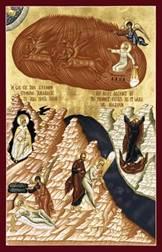 Objectives:
Objectives:
- Students should identify Elisha as the disciple of Elijah.
- Students should be able to tell the stories of Elisha and Naaman.
Possible Lesson Plan:
- Open with prayer.
- Scripture Reference: 4 Kingdoms/II Kings 4:1-36 and chapter 5. We are entering the days of the kings, good and wicked. For over 100 years, Judah,the southern kingdom, enjoyed mostly good kings and prosperity. But, Israel had one wicked king after another until it finally fell to Assyria.
- Learning Game: Let’s try a skit about Naaman – Assign the roles of Naaman, Elisha, King of Syria, little slave girl, Naaman’s wife, and Gehazi. If you want, bring some sheets, towels, scarves, etc., to add a bit of color to the parts.
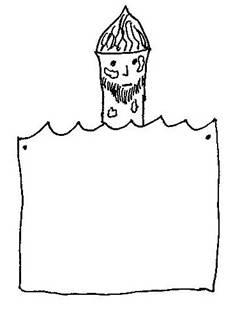 Discuss the importance of obedience: God spoke to Naaman through Elisha. Did Naaman want to obey God? Or did Naaman think that what Elisha asked of him was silly? Who else obeyed God, even though it made him look silly? Noah building the ark? Moses holding his staff over the Red Sea? Joshua marching around Jericho? Gideon with his lamp pots and trumpets? David with his sling against Goliath? Do we always understand why we should obey our parents? God? Or do we always ask, “Why?” and miss the miracle.
Discuss the importance of obedience: God spoke to Naaman through Elisha. Did Naaman want to obey God? Or did Naaman think that what Elisha asked of him was silly? Who else obeyed God, even though it made him look silly? Noah building the ark? Moses holding his staff over the Red Sea? Joshua marching around Jericho? Gideon with his lamp pots and trumpets? David with his sling against Goliath? Do we always understand why we should obey our parents? God? Or do we always ask, “Why?” and miss the miracle.
- Craft idea: Make a “Naaman Doll” – Use a doll clothespin. Use markers to add facial features and aluminum foil for a helmet. Draw sores on the face. Then, make a “river” of blue felt to cover the bottom of the man; make a front and a back and staple or glue together. Punch holes on either side for a hanger.
- Close with prayer. Pray for the faith to be obedient to parents and God.
Jonah
JONAH
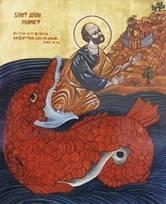 Objectives:
Objectives:
- Students should be able to tell the story of Jonah.
- Students should identify another reason for disobedience – dislike of the command.
Possible Lesson Plan:
- Open with prayer.
- Scripture Reference: Jonah 1-3. Remember that Ninevah was the capital of the Assyrians, who were poised to conquer the entire land of Israel.
- Learning Game: Where in the world is Jonah now? Divide the class into 3 groups. Have each group pretend they are doing the evening news for one of the three cities: Joppa, Tarshish, Nineveh. How would the story of Jonah play in each? Where are these cities?
- Discuss disobedience again: Why did Jonah disobey God? Did he think the command was silly? Did he have trouble hearing God? Or did he dislike the command? Why? Remember that Nineveh was the capital of the Hebrews worst enemy. Did Jonah expect a warm welcome there? Did he have good cause to hate the Assyrians? Are you ever asked to do something you dislike? What? What were the consequences to Jonah for disobedience? What happens to you? What happened after Jonah went to Ninevah? Did God behave “fairly”? Why does God often choose to show mercy when we deserve judgment? Do you usually show mercy to others, or do you like to see people “get what they deserve”? How can we begin to show mercy?
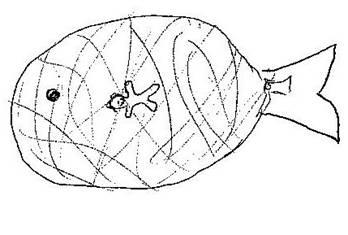 Make a “Jonah Fish”: This is a bit complicated but really neat! First take a single tan or pink pipe cleaner and shape a tiny Jonah. Work your Jonah through the neck of a balloon. Then blow up the balloon part-way to be about 4 or 5 inches diameter and knot. Mix glue and water about 50/50 and soak lengths of gray yarn in the mixture (Messy!). Wrap the yarn every which way around your balloon, but not so tightly that you can’t see Jonah. Let dry overnight hanging by a piece of yarn tied to the balloon knot. Then pop the balloon and carefully extract it from the “fish”, leaving Jonah inside. Glue on a gray felt tail, fins if desired, and wiggle eyes.
Make a “Jonah Fish”: This is a bit complicated but really neat! First take a single tan or pink pipe cleaner and shape a tiny Jonah. Work your Jonah through the neck of a balloon. Then blow up the balloon part-way to be about 4 or 5 inches diameter and knot. Mix glue and water about 50/50 and soak lengths of gray yarn in the mixture (Messy!). Wrap the yarn every which way around your balloon, but not so tightly that you can’t see Jonah. Let dry overnight hanging by a piece of yarn tied to the balloon knot. Then pop the balloon and carefully extract it from the “fish”, leaving Jonah inside. Glue on a gray felt tail, fins if desired, and wiggle eyes.
- Alternate (and less messy) craft: Take a clear, fillable, plastic, round ball ornament. Suspend by a string a tiny figure of Jonah made with pipe cleaners. Close the ball. Cut from blue or gray foam an oval, with a circle cut from the middle to fit the ornament ball. Fit around the ornament containing Jonah and glue in place. Cut tail, two side fins, and top fin from same foam. Cut a slit for the tail and glue in place. Glue side fins and top fin in place. Add wiggle eyes and draw mouth with marker.

- Close with prayer. Pray for the ability to show mercy and especially for any situations the students have mentioned in class.
Isaiah
ISAIAH

Objectives:
- Students should identify Isaiah as a prophet to the kingdom of Judah, the southern kingdom centered around Jerusalem, and Hezekiah as a king of Judah at the time of Isaiah.
- Students should know the story of Isaiah’s calling.
- Students should know that Isaiah prophesied about the coming of the Messiah.
Possible Lesson Plan:
- Open with prayer.
- Scripture Reference: Isaiah 6, 37:33-38:8, 39. This would be a good time to mention again the split between Israel and Judah and that Isaiah was an advisor to the kings of Judah. During Isaiah’s lifetime, the kingdom of Israel in the north would be captured by the Assyrians and utterly destroyed, but Judah was spared, only to fall later to the Babylonians.
- Learning Game: Hangman. Pass out to each student a card with a word from the chapter on it: Isaiah, Hezekiah, Sennacherib, Assyria, seraphim, coal, etc. Play Hangman with each word.
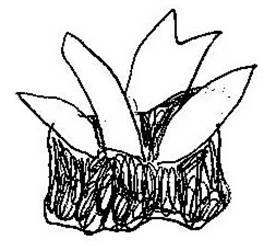 Discuss the role of a prophet: What are some other ways God can speak to us? What did prophets speak about? (the future, yes, but also advice for the kings of their day and words of warning.) Do we have prophets today? Paul talks of prophets in his epistles as an existing ministry. Who might be a prophet today? What warning might today’s prophet give? Can you make a list? Why wouldn’t the people listen to Isaiah’s warnings? Would we listen any better today? What were the consequences for the Hebrew nation, first Israel in the north and then Isaiah’s Judah in the south? What consequences will we suffer today if we fail to listen?
Discuss the role of a prophet: What are some other ways God can speak to us? What did prophets speak about? (the future, yes, but also advice for the kings of their day and words of warning.) Do we have prophets today? Paul talks of prophets in his epistles as an existing ministry. Who might be a prophet today? What warning might today’s prophet give? Can you make a list? Why wouldn’t the people listen to Isaiah’s warnings? Would we listen any better today? What were the consequences for the Hebrew nation, first Israel in the north and then Isaiah’s Judah in the south? What consequences will we suffer today if we fail to listen?
- Make a “Burning Coal”: Take a piece of charcoal. Cut flames from red, orange, and yellow felt and glue to the charcoal. This one’s ridiculously easy! You’ll have to punch a small hole in a flame or two to string a hanger.
- Close with prayer. Pray for ears to hear God’s warnings and to obey them.
Jeremiah
JEREMIAH
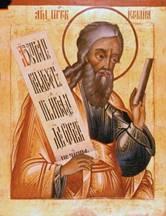
Objectives:
- Students should identify Jeremiah as a prophet who lived in Judah.
- Students should identify Jeremiah as author of the book of Jeremiah and of the Lamentations.
- Students should know that Jeremiah prophesied the fall of Jerusalem to the Babylonians and lived to see that fulfilled.
- Students should identify Nebuchadnezzar as King of Babylon and Zedekiah as the last king of Judah.
Possible Lesson Plan:
- Open with prayer.
- Scripture Reference: Jeremiah 13:1-11 and (if there’s time) chapter 28. Jeremiah like Isaiah preached in Judah, the southern kingdom, but later, under the reign of Zedekiah, the last king of Judah. Jeremiah, and his student Baruch, wrote down all that God had told him, but the king burned the scroll. They wrote the prophecies again for us to read. Jeremiah also wrote a letter, or epistle, and the book of Lamentations, lamenting the fate of Jerusalem at the hands of the Babylonians. During this time, the Babylonians sacked the temple and took captives; later they returned and leveled the city. During this time, the Babylonians sacked the temple and took captives; later they returned and leveled the city.
- Learning Game: Out-lister – Give the students each a paper with three headings across the top: Kings, Prophets, Bible Places. Give them 5 minutes to write as long a list as they can for each category. The student with the longest total list is the winner, but he must be ready to identify the entry if questioned about its appropriateness.
- Discussion: What did God say to Judah with the belt (or girdle) demonstration? Was there truth to the statement? How did Jeremiah tell us how to tell a true prophet from a false one? Why was Jerusalem destroyed? Was God “fair” to the Jewish people? Jeremiah was persecuted throughout his life for obeying God – beaten and thrown in prison and tortured. Was God “fair” to Jeremiah? Why or why not? There are many countries today where Christians are still being persecuted – beaten, imprisoned, or even killed – for obeying God. Would you be willing to serve God, even to the point of persecution? Is there a time in your life when you could have stood up for your beliefs, e.g. in school, and didn’t? Why?

- Make Jeremiah’s Girdle: Cut a 1x6-inch piece of felt. Punch 4 holes in each thin end and fringe with small pieces of yarn.
Close with prayer. Pray that we will have the strength to stand up for our beliefs, no matter what the cost.
Ezekiel
- EZEKIEL

Objectives:
- Students should identify Ezekiel as a prophet during the Babylonian captivity.
- Students should identify Ezekiel as the author of the book of Ezekiel.
- Students should know at least one of his major visions – the bones.
Possible Lesson Plan:
- Open with prayer.
- Scripture Reference: Ezekiel 1:1-28, 3:1-9, 37:1-14. Ezekiel was a contemporary of Jeremiah but was one of the many taken captive by Babylon (along with Daniel and his 3 friends). Initially, Nebuchadnezzar did not destroy Jerusalem or the Temple and left Zedekiah as puppet king. Ezekiel prophesied from Babylon and Jeremiah from Jerusalem, calling the people to repentance. But they would not listen, and 10 years later the Temple of Solomon was destroyed and the city of Jerusalem wrecked.
- Learning Game: Pictionary. There are 3 major visions here described. Assign each to one student and have the chosen student try to draw the vision for the class to guess.
- Service Reference: When do we hear the vision of the bones in Church? Every year during Holy Week! Which service? (Holy Saturday matins, usually celebrated Friday evening). Icon Reference: In most Orthodox Churches there is a representation of Ezekiel 1: 10 – “As for the likeness of their faces, each had the face of a man; each of the four had the face of a lion on the right side, each of the four had the face of an ox on the left side, and each of the four had the face of an eagle.” We see here Jesus the man as God incarnate, Jesus the lion for His divinity, Jesus the calf for His sacrifice for our sins, and Jesus the eagle for His resurrection and ascension. And, traditionally, these are each associated with one of the Evangelists – the man for Matthew, the eagle for John, the bull for Luke, and the lion for Mark. So in our own church look again to see the huge ceiling icon and each of the writers of the gospels in the ceiling corner indicated by his symbol.
- Discussion: What is the meaning of the vision of the bones? The wheels? The scroll? Who else in the Scriptures had a vision? (Jacob and his ladder, etc.) Have you ever had a dream? Who else in the Scripture had dreams? (e.g., Joseph). What’s the difference between a vision and a dream? Have you ever had a vision? Do people have visions today anyway? What about dreams?
- Make “Ezekiel’s Bones”: Cut the skeleton on the next page out of heavy white paper or poster board, about the same size as it is on the paper. Punch holes where indicated, and use small pieces of white pipe cleaner to attach the bones to form a skeleton, with another piece of pipe cleaner as hanger from the top of the head.
- Close with prayer. Ask God to speak to us all day, even in our dreams.
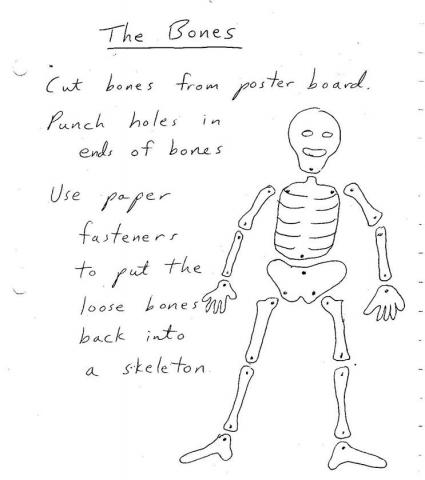
Shadrach, Meshach, and Abednego
SHADRACH, MESHACH, AND ABEDNEGO
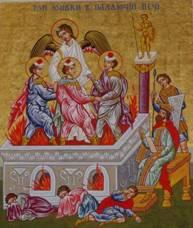
Objectives:
- Students should be able to identify Shadrach, Meshach, and Abednego as the three young men in the fire and tell their story.
- Students should identify Nebuchadnezzar as King of Babylon and the Jewish people as his prisoners.
- Students should begin to understand the reference to the three young men in the fire as a foreshadowing of the death and resurrection of Jesus.
Possible Lesson Plan:
- Open with prayer.
- Scripture Reference: Daniel 3. Daniel and his friends, were taken as captives to Nebuchadnezzar’s palace in Babylon. They were given Babylonian names: Daniel became Belteshazzar, Hananiah became Shadrach, Mishael became Meshach, and Azariah became Abednego. I’ve never figured out why Daniel is known by his Jewish name and the others by their Babylonian names!
- Learning Game: The Big Step. Just as before, line up the students at one end of the classroom and the teacher at the other. Ask questions from the lesson. If the student gives the correct answer, he can take a step. If not, take the question to the next student. First to cross the room is the winner.
- Discussion: The story of the 3 young men in the fire is told over and over in the canons around Pascha-time. Why? This story from the Old Testament is thought to be a foreshadowing of the descent of Christ into hell to save the captives. What is a foreshadowing? Who does Nebuchadnezzar represent?
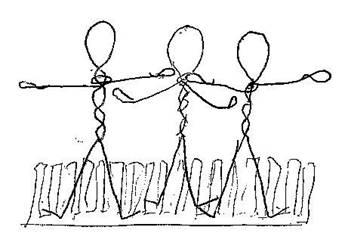 Make the “Three Young Men in the Fire”: Fashion 3 tiny people from a pipe cleaner or two each. You can put some fabric-scrap robes on them if desired. Then take a piece of orange crepe paper about 2 feet long and cut fringes on one side. Line up the 3 figures and wrap the crepe paper around their legs several times to simulate fire. Glue them and the crepe paper together. You can attach a hanger to the head of the middle person.
Make the “Three Young Men in the Fire”: Fashion 3 tiny people from a pipe cleaner or two each. You can put some fabric-scrap robes on them if desired. Then take a piece of orange crepe paper about 2 feet long and cut fringes on one side. Line up the 3 figures and wrap the crepe paper around their legs several times to simulate fire. Glue them and the crepe paper together. You can attach a hanger to the head of the middle person.
- Close with prayer. Ask for courage to stand up for our beliefs no matter what as did Shadrach, Meshach, and Abednego.
Tobit
TOBIT
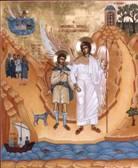 Objectives:
Objectives:
- Students should be able to identify the Apocrypha as books included in the Greek Septuagint but not in the Hebrew version of the Old Testament.
- Students should be able to tell the story of Tobit.
Possible Lesson Plan:
- Open with prayer.
- Tell the story of Tobit (use highlighted words for the game board):
During the sad days when the Jewish people were held as slaves by
the Babylonians, there lived a man named Tobit. Tobit had a son named Tobias. Tobit and Tobias, even though they were captives of the Babylonians, helped their fellow-Hebrews whenever they could. Because of this, the king Esarhaddon did not like Tobit and Tobias and made their lives hard. Finally Tobit became blind; he could not see at all. Life seemed hopeless, and Tobit prayed to God that he should die.
At the same time, in Ecbatana, there lived a Hebrew girl named Sarah. She was also praying to God. Seven times she was married; and seven times the demon Asmodaeus killed her new husband on their wedding night.
One day, Tobit sent his son Tobias to Media to collect ten silver coins; they needed the coins to live since Tobit could not work. He hired a man named Azariah as a traveling companion, but Azariah was really the angel Raphael, sent by God to heal both Tobit and Sarah. As they traveled by the river Tigris, Tobias caught a fish. Azariah told him to save the heart, liver, and gall of the fish. Soon Tobias arrived in Ecbatana. There he met Sarah. They were cousins! Tobias fell in love with Sarah and they decided to get married. On their wedding night, Tobias burned the heart and liver of the fish; the awful smell drove the wicked demon away to Egypt. Sarah and Tobias were saved!
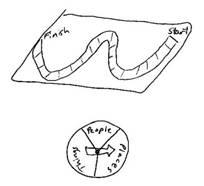 Tobias returned home to his father. What rejoicing! He had been gone so long that Tobit had thought he had been killed. Tobias rubbed his father’s eyes with the gall of the fish. Tobit could see again! They thanked God for His faithfulness and goodness in sending the angel Raphael to help them.
Tobias returned home to his father. What rejoicing! He had been gone so long that Tobit had thought he had been killed. Tobias rubbed his father’s eyes with the gall of the fish. Tobit could see again! They thanked God for His faithfulness and goodness in sending the angel Raphael to help them.
- Learning Game: Make a game. Draw an S-shaped game path on a piece of poster board. Divide into spaces. On each space, write the name of a character, a place, or a thing from the story. Make a spinner from a small paper plate. Divide it into 3 sections. Label each section “people”, “places”, or “things”. Attach cardboard spinner with brad. When each player spins, he moves to the next space on the board of that category.
- Discussion: What is the Apocrypha? (books contained in the Greek version of the Old Testament, known as the Septuagint, but not in the Hebrew. Why do some Christians include it in their Bible and some do not?
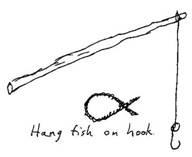
- Make “Tobias’s Fishing Rod”: Make fish and hook out of pipe cleaners and use yarn or thread or string as the line. Rod can be a twig or a brown pipe cleaner.
Close with prayer.
Daniel
- DANIEL
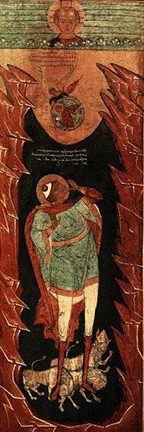
Objectives:
- Students should identify Daniel as a prophet and author of the book of Daniel.
- Students should be able to tell the story of Daniel in the lion’s den.
- Students should identify Belshazzar as the last king of Babylon and to tell the story of the handwriting on the wall and to name Cyrus as the Persian conqueror.
Possible Lesson Plan:
- Open with prayer.
- Scripture Reference: Daniel 5 & 6. Remind the students that Daniel lived during one of the most exciting periods in the history of Mesopotamia (Where’s that?). Babylon, under Nebuchadnezzar, rose to its greatest prominence, with its Hanging Gardens one of the wonders of the ancient world. But, under Belshazzar, his successor, Babylon was conquered by Cyrus of Persia, who marched into the city with his army in the dead of night on the dry bed of the Euphrates River that flowed under the city walls (after damming the river!). Cyrus was succeeded by Darius, the king in the story of the lion’s den. Darius is known to students of Greek history as the Persian king who lost the battle of Marathon outside Athens. It was after this famous battle that the runner, Pheidippides, ran 26 miles to Athens to gasp out the news that they had won. He then died. To this day, a “marathon” is a 26-mile run.
- Learning Game: Divide the class into 2 groups. Each group has 5 minutes to prepare a skit about either “The Handwriting on the Wall” or “Daniel in the Lion’s Den”. Then have each group perform for each other.
- Discussion: God protected and helped Daniel in difficult situations. Which ones? How has God helped and protected you and your family? Daniel was obedient to God. Why is obedience important? What did Samuel say to Saul? Daniel had great faith in God. What does it mean to have faith? Why is faith important? How does obedience show faith? Daniel always put God first in his life. How did he show this? Do you put God first? How do you show it?
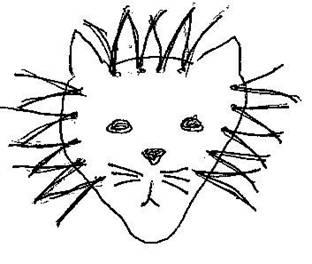
- Make “Daniel’s Lion”: Cut a lion head shape about 3x4 inches from gold felt or foam. Fringe it (same way as in Jeremiah’s girdle) all around with a brown mane. Draw in the facial features with marker, or use wiggle eyes and black-yarn whiskers.
- Close with prayer. Pray especially to put God first in our lives, as Daniel did in his.
Esther
ESTHER
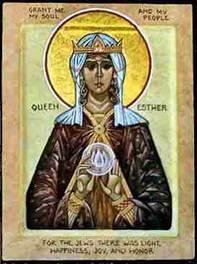
Objectives:
- Students should be able to identify Esther as Queen of Persia and her husband Ahasuerus (also known in Greek as Xerxes) and Mordecai and Haman.
- Students should be able to tell the story of Esther and should know that this story is retold in Jewish synagogues every year at the festival of Purim.
Possible Lesson Plan:
- Open with prayer.
- Scripture Reference: Esther 5:1-8 and chapter 7. Unless you want to read the entire book, set the scene for the students. Ahasuerus, also known as Xerxes (his Greek name), king of Persia, chose Esther, a Jewish girl living in in Persia, as his queen, after his previous queen, Vashti, refused to obey him. Haman was his chief advisor. Mordecai, Esther’s cousin, has learned that Haman has tricked the king into ordering the death of all the Jews. But, Esther is not supposed to go to her husband, the king, unless he first calls her; the punishment is death! As you read the Scriptures aloud, have the students shake noisemakers and boo every time the villain, Haman, is named. This is exactly the way Purim, the holiday commemorating Esther, is celebrated in a Jewish synagogue to this day.
- Learning Game: Line ‘em up! – Write the events of the story on cards, one for each student. Have the students read their cards aloud and line up in the correct order to tell the story.
- Discussion: Esther was willing to go to the king even if she died for it. This decision took great courage. What decisions have you made that took courage? What do you think might have happened if Esther had been too afraid to go before the king? Mordecai believed that God would take care of Esther. How does God care for us?
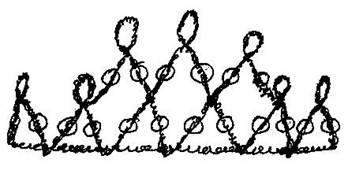
- Make “Esther’s Crown”: Take gold pipe cleaners. Shape a crown like a tiara with the pipe cleaners (each can look a bit different), adding blue beads along the way for added beauty.
- Close with prayer. Pray for courage like Esther.
Minor Prophets -- Habakkuk
MINOR PROPHETS: HABAKKUK
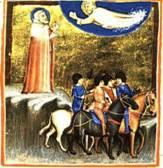
 Objectives:
Objectives:
- Students should identify Habakkuk as a prophet who prophecies of the coming Messiah, Jesus Christ.
- Students should be able to tell of his message to the people of Judah.
- Students should be able to tell the story of Daniel and Habakkuk.
- Students should learn the names of all 12 “minor prophets”.
Possible Lesson Plan:
- Open with prayer.
- Scripture Reference: Habakkuk lived in the land of Judea during the time of the prophets Daniel and Jeremiah. Read Daniel 22:33 -- In the book of Daniel, according to the Septuagint, an angel told Habakkuk to take his stew and bread to Daniel while he was in the lion’s den. Habakkuk was in Judea; Daniel in Babylon. The angel transported Habakkuk to Babylon and provided food for Daniel! The icon on the right pictures Daniel in the lion’s den with Habakkuk and the angel above him and Christ above all. As to the message of the Lord to His people through Habakkuk, Habakkuk saw the terrible evil among his own people and spoke to them of God’s coming judgment at the hands of the Babylonians. The icon on the left pictures Habakkuk’s vision of the Babylonian army in its pride. Who then can we trust? Read Habakkuk’s answer in Habakkuk 3:17-19. Finally, read 2:20 and 3:3 – prophecies of the coming of Jesus 600 years before the Nativity. Habakkuk – a short book with a lot to say!
- Learning Game: Try Concentration with all 12 minor prophets.
- Discussion: How would you like to go down in history as a “minor prophet”? No one knows who you are or what you said and did individually! But these were real people, speaking for the Lord from very different vantage points. Compare and contrast Habakkuk and Jonah (whom you’ve already met). Where were they from? Who were they to speak to? What was the response of each to God’s calling? What was the message? What was the outcome for each?
- Make “Habakkuk’s Stew Pot: Take a bottle cap. Fill half way with glue and add dried beans. Glue on a handle of pipe cleaner to hang on your Jesse tree.
- Close with prayer. Pray that we will respond to God’s call as did Ninevah, and not as did Judah.
Minor Prophets -- Micah
MINOR PROPHETS: MICAH
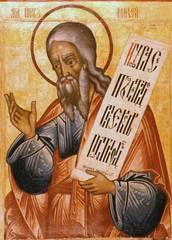
Objectives:
- Students should be able to identify Micah as a prophet who lived in Judah, the southern kingdom.
- Students should know that Micah prophesied the birth of Jesus in Bethlehem.
- The main thrust of Micah’s message was the destruction of Samaria and Jerusalem.
- Continue to work on the names of all the “minor prophets”.
Possible Lesson Plan:
- Open with prayer.
- Scripture Reference: Micah 1:1-12, Micah 6:8 and Micah 5:2-4. Micah lived near Jerusalem, a contemporary of Isaiah, but correctly prophesied the destruction of Jerusalem 100 years later.
- Learning Game: Quotations – Take a well-known quotation from each of the “minor prophets” (yes, there are well-known quotations, you just may not know where they’re from!) and write each on an index card. Tear the cards in half and give one half of each quote to each student and hide the other around the room. Students must find their missing half. Now read all aloud. Some suggestions would be:
Hosea 11:1 Obadiah 4 Nahum 1:3a Haggai 2:9
Joel 3:10 Jonah 2:1 Habakkuk 3:19 Zechariah 9:9
Amos 3:7 Micah 6:8 Zephaniah 1:7a Malachi 3:1a
- Review the prophecies about the Christ: Isaiah? (born of a virgin, a Nazarene, suffering and death); Micah? (born in Bethlehem); Jeremiah? (the slaying of all children under two); Zechariah? (riding on a donkey), Malachi (John the Baptist). These prophecies are scattered all over the Old Testament, yet Jesus fulfilled them all!
Make a "Prophet Catcher" to help learn these important but confusing men of God:
Prophet Catcher
- With the printed side up, fold the square in half horizontally and then vertically, open the folds. Turn the square over.
- Fold each corner over so they meet in the middle, do not let them overlap.
- Leave the square folded, and flip the square over.
- Now fold the corners into the center – make sure they do not overlap.
- Fold the entire square in half and poke your thumbs and forefingers under flaps.
- Bring your fingers together so the Fortune Teller forms a peak –
- YOU are ready to PLAY!
Amos, the shepherd, Habakkuk with his pot of stew for the Prophet Daniel, Micah and his prophecy of the city of Bethlehem, and Haggai with the rebuilding of the temple in Jerusalem are on the 4 outside flaps. Can the students correctly identify the prophets associated with the quotes beside the numbers?
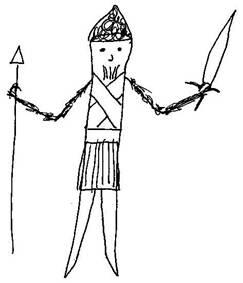
- Make a soldier of Babylon (or Assyria): Take a clothespin dollpin. Add tinfoil helmet, ribbon or fabric uniform, marker face, and arms, spear, and sword from pipe cleaners.
- Close with prayer. Thank the Lord for sending His Son, just as He promised so many years ago with His prophets.
Ezra and Nehemiah
EZRA/NEHEMIAH
Objectives:
- Students should be able to identify Ezra as the priest who brought the law back to Jerusalem.
- Students should identify Nehemiah as the Jewish governor who rebuilt the city wall.
- Students should identify Cyrus and Darius as the kings of Persia who allowed the work.
Possible Lesson Plan:
- Open with prayer.
- Scripture Reference: Nehemiah 2:1-6, 4:6-23, 8:1-9.
- Learning Game: Try 20 Questions: Write the names of Ezra, Nehemiah, Artaxerxes on slips of paper. Let a student choose a name; the others have 20 questions (“yes” or “no” only) to guess the identity of the person. Then move on to the next name.
- Discussion: This is a good time to review this very difficult period in Jewish history. Remind the children of the line of kings from Saul to David to Solomon and the glory of the temple in Jerusalem. Review the split of the people into the northern kingdom, Israel, with its capital in Samaria and the southern kingdom, Judah, with its capital in Jerusalem. With older children, you can make comparisons with our own Civil War. God was not happy! He sent prophets to both kingdoms – Elijah and Elisha to Israel and Isaiah, Amos, Micah, and Jeremiah to Judah. Which prophet was sent to the Assyrians? (Jonah) Review the fall of Israel to the Assyrians and of Judah to the Babylonians. Who was the king of Babylon? (Nebuchadnezzar). Who were some of the prisoners taken back to Babylon? (Shadrach, Meshach, Abednego, Daniel, Ezekiel) Review their stories from captivity. Now Nebuchadnezzar’s heir Belshazzar has fallen to Cyrus of Persia (He sneaked into Babylon in the bed of the river). People began returning to Palestine from Babylon in the days of Cyrus of Persia under the Jewish governor Jerubbabel. But work on the city bogged down due to opposition from their neighbors and did not resume for 15 years during the reign of Darius. Now, with the blessing of Artaxerxes, Ezra is sent to re-institute the law and Nehemiah to rebuild the wall, each with the blessing of Persia. Haggai and Zechariah preached during the early work and Malachi during the time of Nehemiah.
 Make “Ezra’s Scroll of the Law”: Take a piece of paper and roll it up like a scroll. Tie with a ribbon or piece of yarn. Review the 10 Commandments to be sure they’re still memorized.
Make “Ezra’s Scroll of the Law”: Take a piece of paper and roll it up like a scroll. Tie with a ribbon or piece of yarn. Review the 10 Commandments to be sure they’re still memorized.
- Close with prayer. Pray that we may also keep the law of the Lord close to our hearts.
Maccabees
MACCABEES
Objectives:
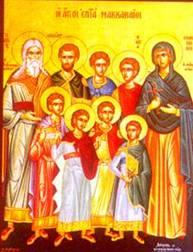 Students should be able to identify Judah Maccabee as the hero and Antiochus as the wicked king.
Students should be able to identify Judah Maccabee as the hero and Antiochus as the wicked king.- Students should know that the story of Maccabees is the basis for the Jewish feast of Hanukkah.
- Students should understand the meaning behind the 8 candles of the Hanukkah menorah and the one to use to light the others.
Possible Lesson Plan:
- Open with prayer.
- Tell the story of Judah Maccabee and his brothers:
Church School will start a bit late today, because I’ll use my tape, “The Story of Hanukkah” to tell the story for everyone during opening exercises.
- Play with a dreidl: You can get one of these from Pat or at any store. Each letter has a meaning. Each child starts with about 20 raisins. Each puts one raisin in the center of the table. They take turns spinning the dreidl. If it lands on Nun, they get nothing. If it lands on Shin, they have to give a raisin to each player. If it lands on Heh, they get half of the raisins in the center. And if it lands on Gimel, they get all the raisins in the center. When you decide time is up, the child with the most raisins is the winner, and each gets to eat his raisins.
- Discussion: Hanukkah is celebrated in late December and is often referred to as the “Jewish Christmas”. Does Hanukkah have anything to do with the birth of Jesus? Whose story is told? We left Jewish history with the return from Babylon under the Persians. But the Persians were ousted by the Greeks under the Macedonian king Alexander the Great. Alexander’s empire collapsed with his death, but the Greek influence continued in Palestine under a whole dynasty of kings, all with the same name! What was it? (Antiochus). It was Antiochus IV with whom the Maccabees had problems. What miracle occurred? How many days did the lamp in the great menorah burn? Why are there nine candles on the Hanukkah menorah? (one to light the others with)
- Service Reference: We sing to the Maccabees and their courage equal to the martyrs.
Kontakion:
O, ye seven pillars of the wisdom of God,
Seven-branched lamp of the light divine.
O, most-wise Maccabees, who before the martyrs
Were martyrs most great.
With them entreat ye the God of all
That we who honor you may be saved!
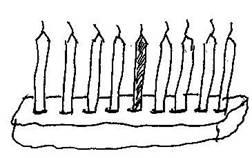 6. Make a clay Menorah: Shape a base from air-dry clay and paint blue. Decorate with gold-painted or glitter-pen stars of David if desired. Insert 8 birthday candles of one color and a middle candle of another color. Allow to dry.
6. Make a clay Menorah: Shape a base from air-dry clay and paint blue. Decorate with gold-painted or glitter-pen stars of David if desired. Insert 8 birthday candles of one color and a middle candle of another color. Allow to dry.
7. Close with prayer. Pray that we may recognize the miracles in our lives, just like the miracle of the menorah.